Case Study:
🧠 How We Grew Organic Traffic from 0 to 103,385 Monthly Visitors in 5 Months
— Using AI and a Scalable SEO System
📈 Overview
In late 2024, a fast-growing AI startup (a video summarization platform) approached Mythos360 with one goal:
“We need to build a predictable inbound traffic engine — without depending on ads, backlinks, or slow SEO agencies.”
They were in the middle of a rebrand, which is why we can now share the strategy publicly.
They had:
-
Zero SEO traction
-
No blog
-
No keyword map
-
No content team
We designed and deployed a lean, AI-powered system to generate, structure, and publish over 200 pages of high-value content in just a few weeks. In this article, we’ll share how we launched AI Video Summarizer Noiz.io and reached 103,385 monthly visitors from scratch in just 5 months – and still growing.
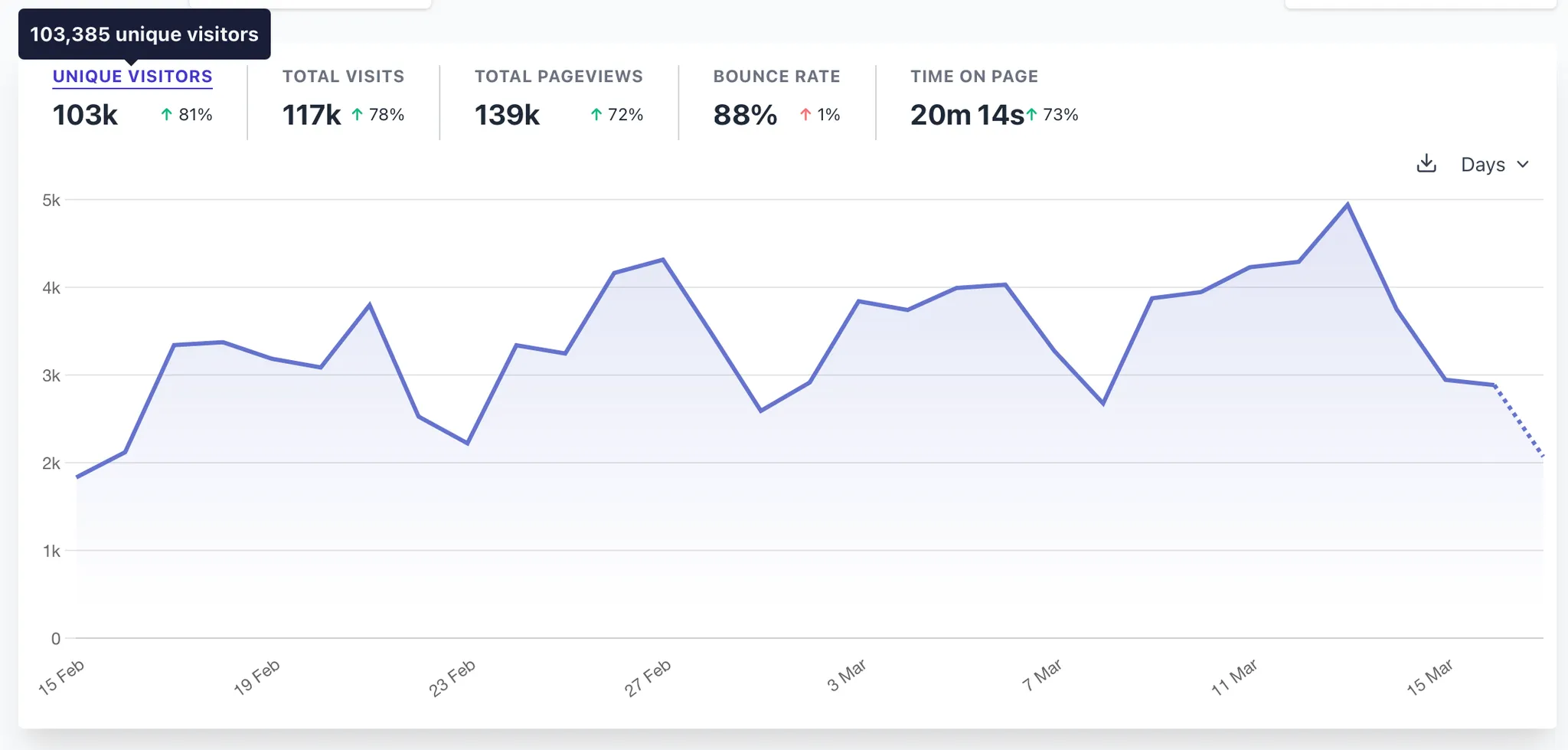
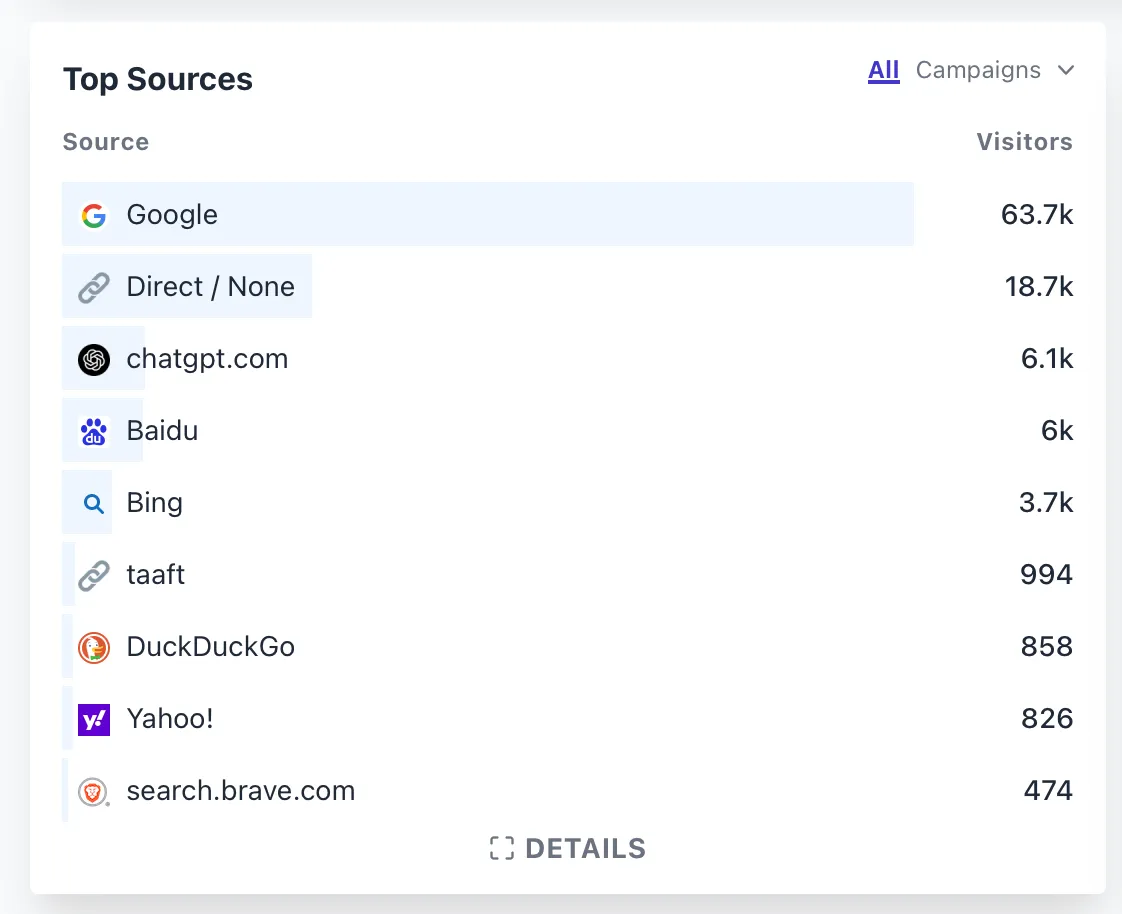
🛠️ Domain Acquisition
We began by acquiring an aged domain with a strong backlink profile and a Domain Rating (DR) of 55. This provided a solid foundation for our SEO efforts, allowing for quicker indexing and improved credibility with search engines.
Choosing the right domain is crucial for SEO success, especially when aiming for quick results.
New domains typically rank poorly for 6-12 months, and accelerating this process is expensive and labor-intensive. Our experiments showed that aged but empty domains (domains that someone bought and held without using) perform just as poorly – even if a domain shows as 10 years old, it won’t perform much better than a new registration.
Key criteria we set for quick results:
- Active project history – the domain must have hosted a live project
- Memorable, easy-to-spell name
- Related niche (mobile apps, extensions, or AI tools in our case)
- Strong backlink profile with quality mentions from reputable sources
- Domain Rating of at least 40 (we targeted DR 50+)
- No history of Google penalties or bans
Finding a domain meeting all these criteria proved challenging. Quality domains rarely go on sale. When they do, they’re either extremely expensive or have hidden issues – like recent Google penalties that sellers try to offload before traffic drops.
Our niche requirements further limited our options. We couldn’t use domains from unrelated industries like healthcare or metallurgy – it would be hard to explain to Google why a long-standing medical website suddenly became a YouTube AI summarizer.
With suitable domains at auctions reaching $50,000-$100,000, we needed a different approach.
We decided to target domain owners who weren’t actively selling but might consider an offer. Our ideal candidates were entrepreneurs with failed startups who kept their domains either for sentimental reasons, fear of losing something valuable, or to support remaining users.
Since most of these owners weren’t earning significant revenue, selling a high-DR domain could be attractive – offering both financial return and a successful exit story for their portfolio.
Here’s how we found these domains:
- Scraped all Product Hunt projects from the last 10 years
- Filtered for inactive sites (no content updates in 6+ months)
- Our reasoning: no updates likely meant a dead project
- This gave us about 3,000 potential targets
- Further filtered for DR 30+, leaving 1,718 matching domains

Next, we searched for email addresses using our internal parser combined with snov.io, which proved highly effective.
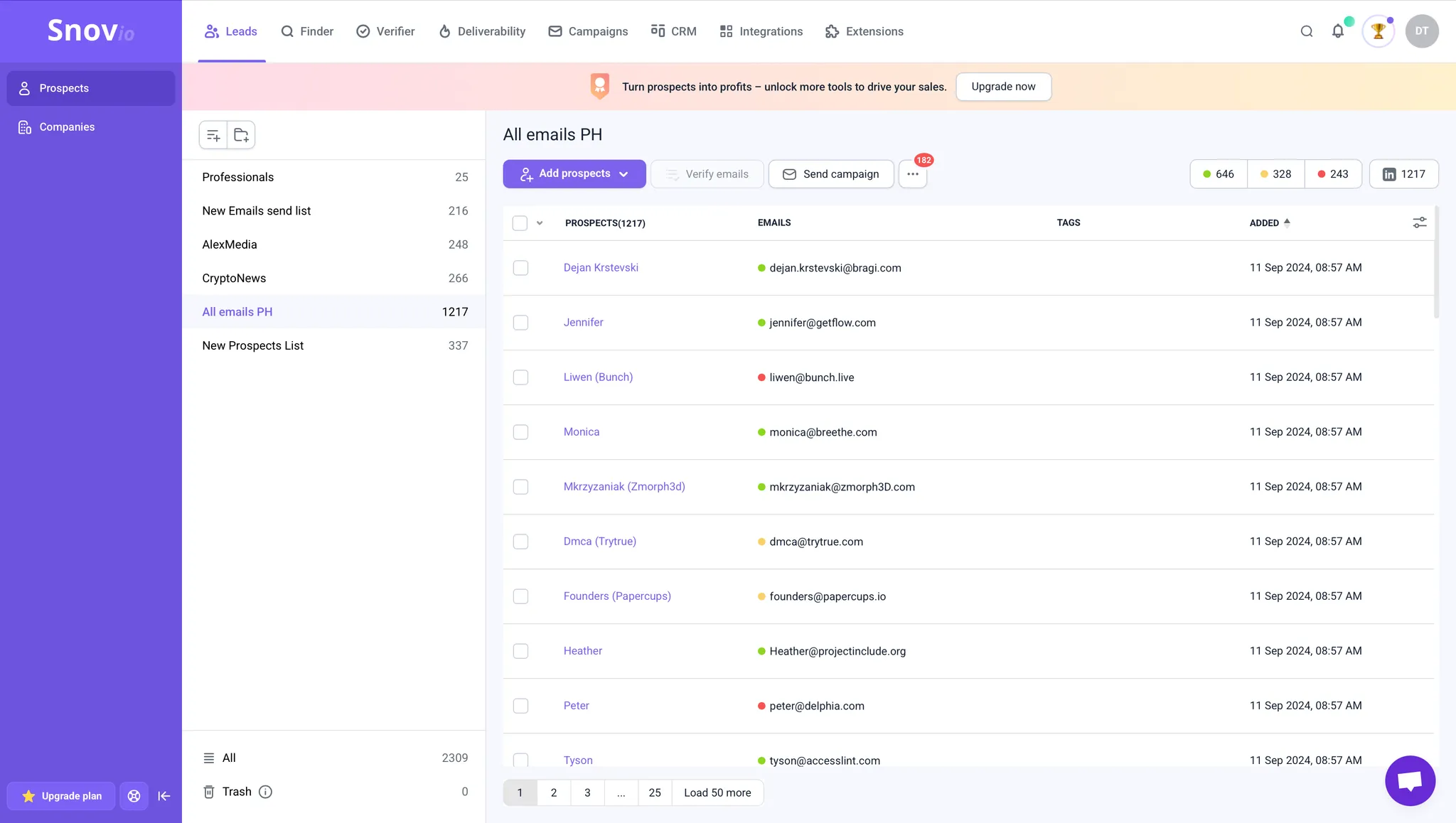
We found valid emails for about 768 domains, sometimes multiple addresses per domain, totaling 890 validated contacts.
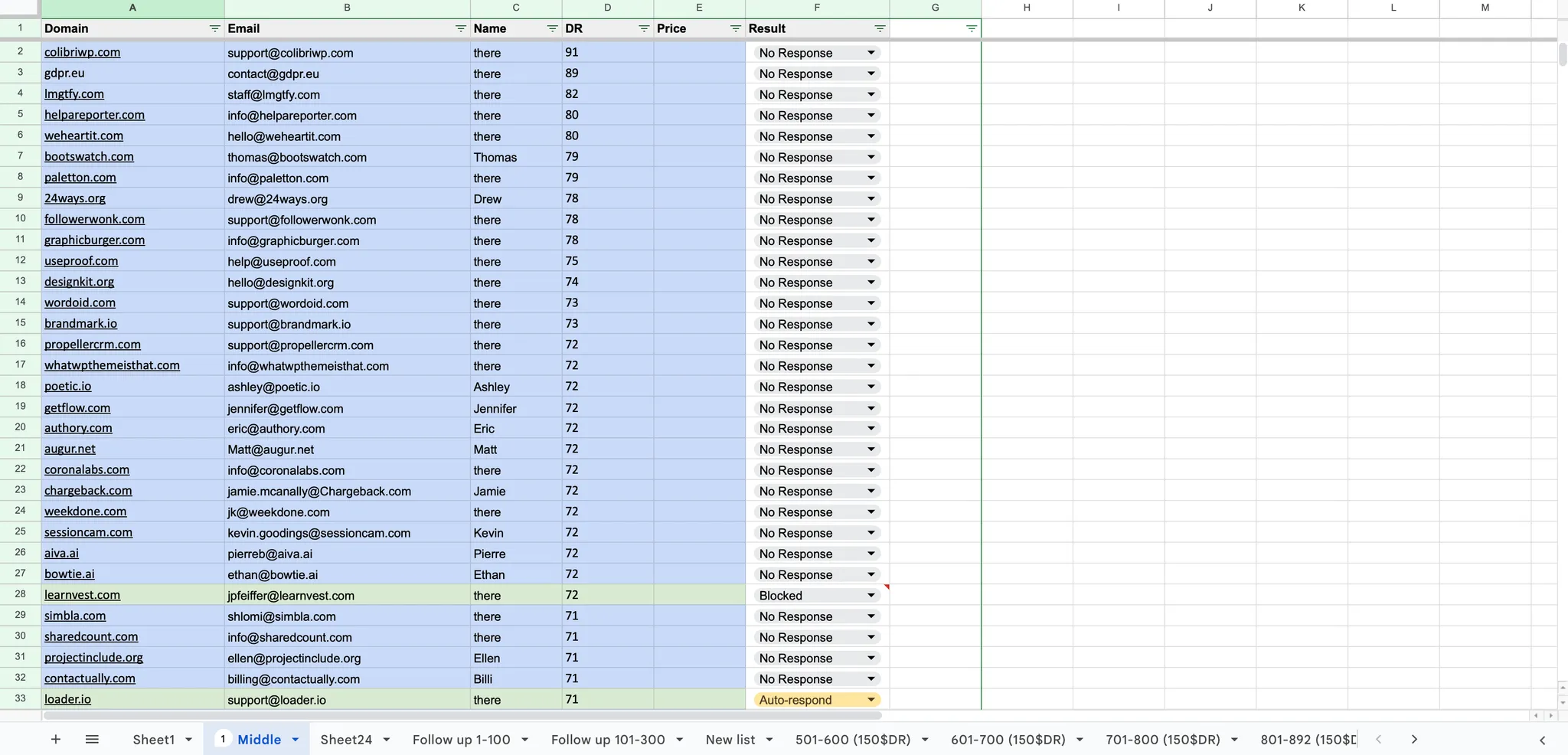
For mass emailing, we chose Gmass – perfect for small cold email campaigns. It’s effective for one-time or periodic mailings, simple, and affordable. It works directly with Gmail, integrates with Google Sheets, and takes 10 minutes to set up. You can safely send 100-200 emails daily without risking account bans.
The service is ideal for handling several hundred addresses when you need a quick solution without complex email chains, automation, or advanced analytics.
You connect Gmass to a Google Sheet where each column is a variable. Insert these variables into your email template, and the service automatically personalizes each message.
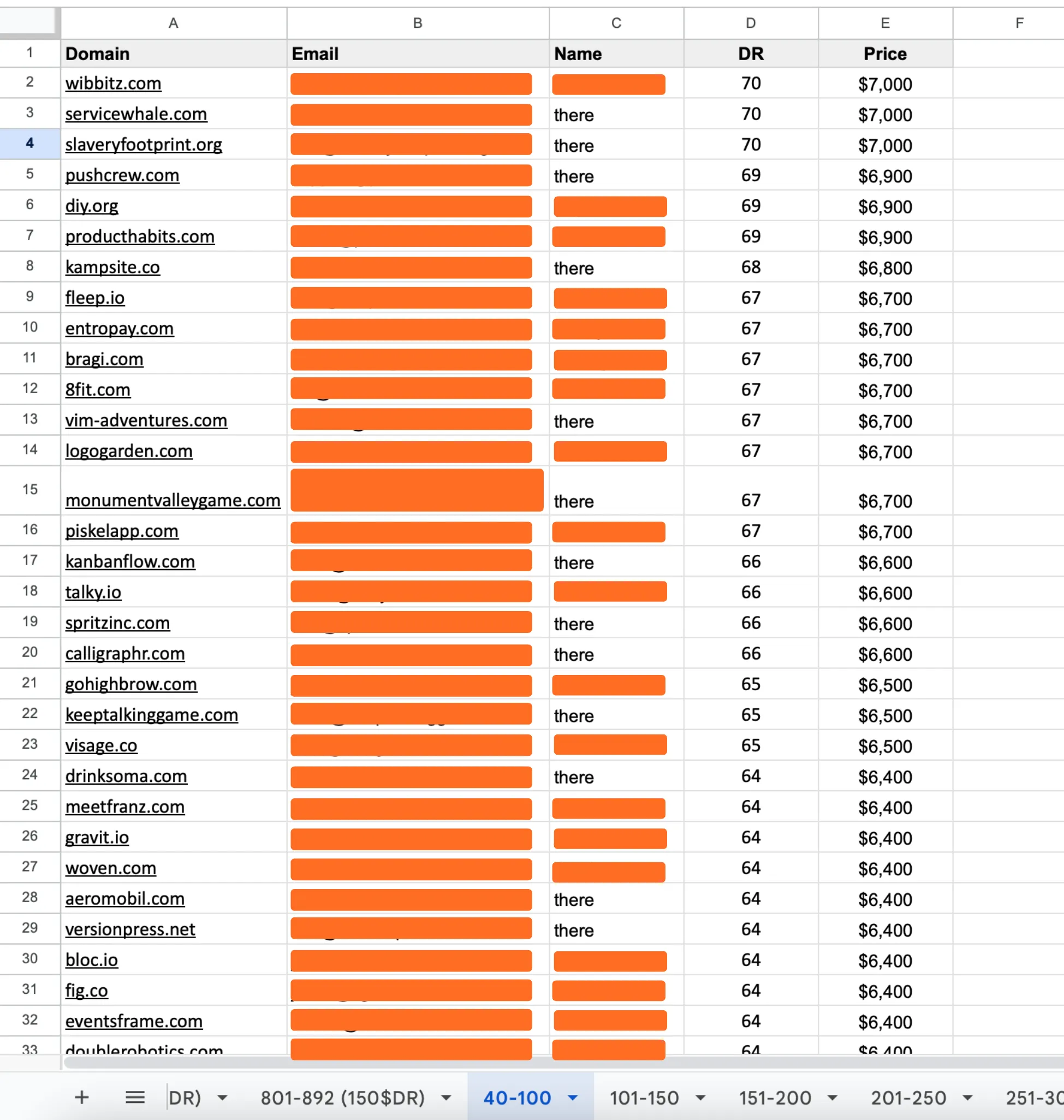

We A/B tested several email bodies and subject lines to improve open rates and response rates. Gmass generates reports to track these metrics.

We set initial domain prices using the formula: DR * $100. For example, a domain with DR 50 was priced at $5,000. While below market value, this gave us room for negotiation.
We started receiving responses from owners. Some wanted higher prices, some were ready to sell, others declined.
In 3 weeks, we:
- Emailed 890 addresses
- Received 50 responses
- Got 10 interested sellers
- Had 40 rejections
- Sent follow-ups with 50% higher offers to non-responders
- Got 10 more interested parties
- Conducted 10 meetings
- Purchased 2 domains
We bought the first domain (DR 55) for $8,000 – several times below market value. It previously belonged to a relaxation music app. The founder sold quickly with minimal negotiation, happy to help fellow startups and give the domain new life.

We also bought a second domain with DR 21 for $1,000. We got this one for riskier experiments – if anything went wrong, we wouldn’t lose much.
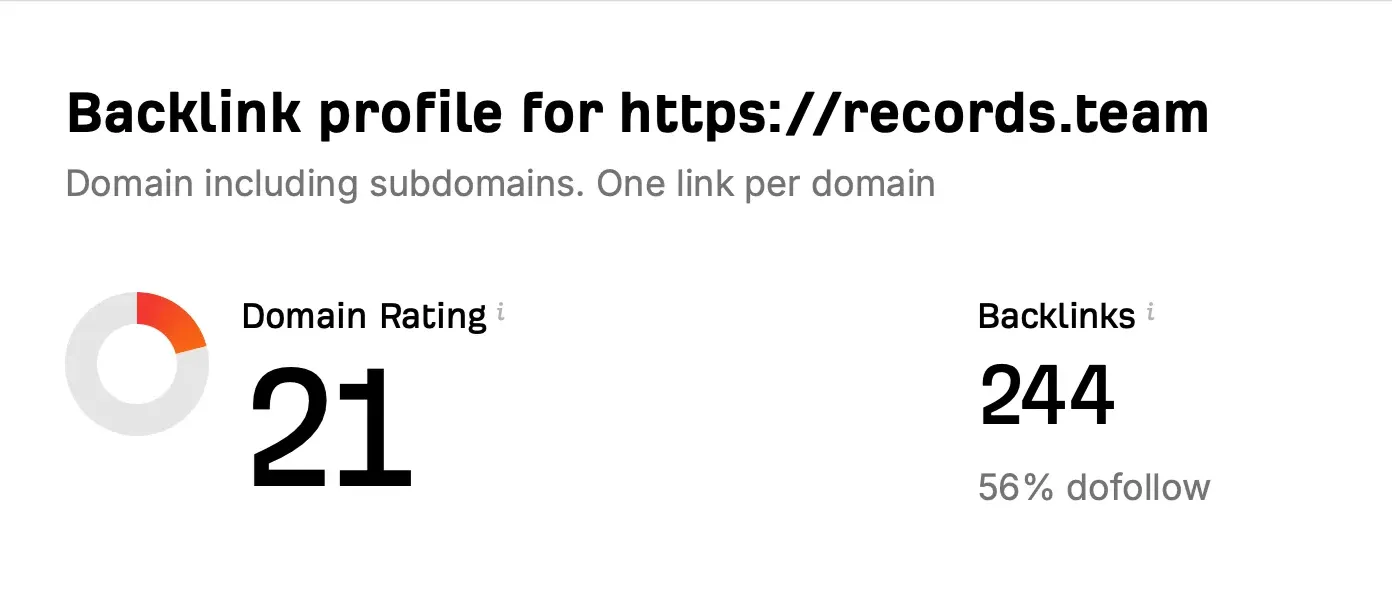
🔍 SEO Strategy
Our team conducted an in-depth analysis of competitors to identify high-traffic AI tool opportunities with minimal competition. This informed our content strategy and helped us target niches with the highest potential for growth.
We started by analyzing 15 services that offer video summarizing & transcribing, either as their main feature or as a core functionality, and use SEO as a major traffic source.
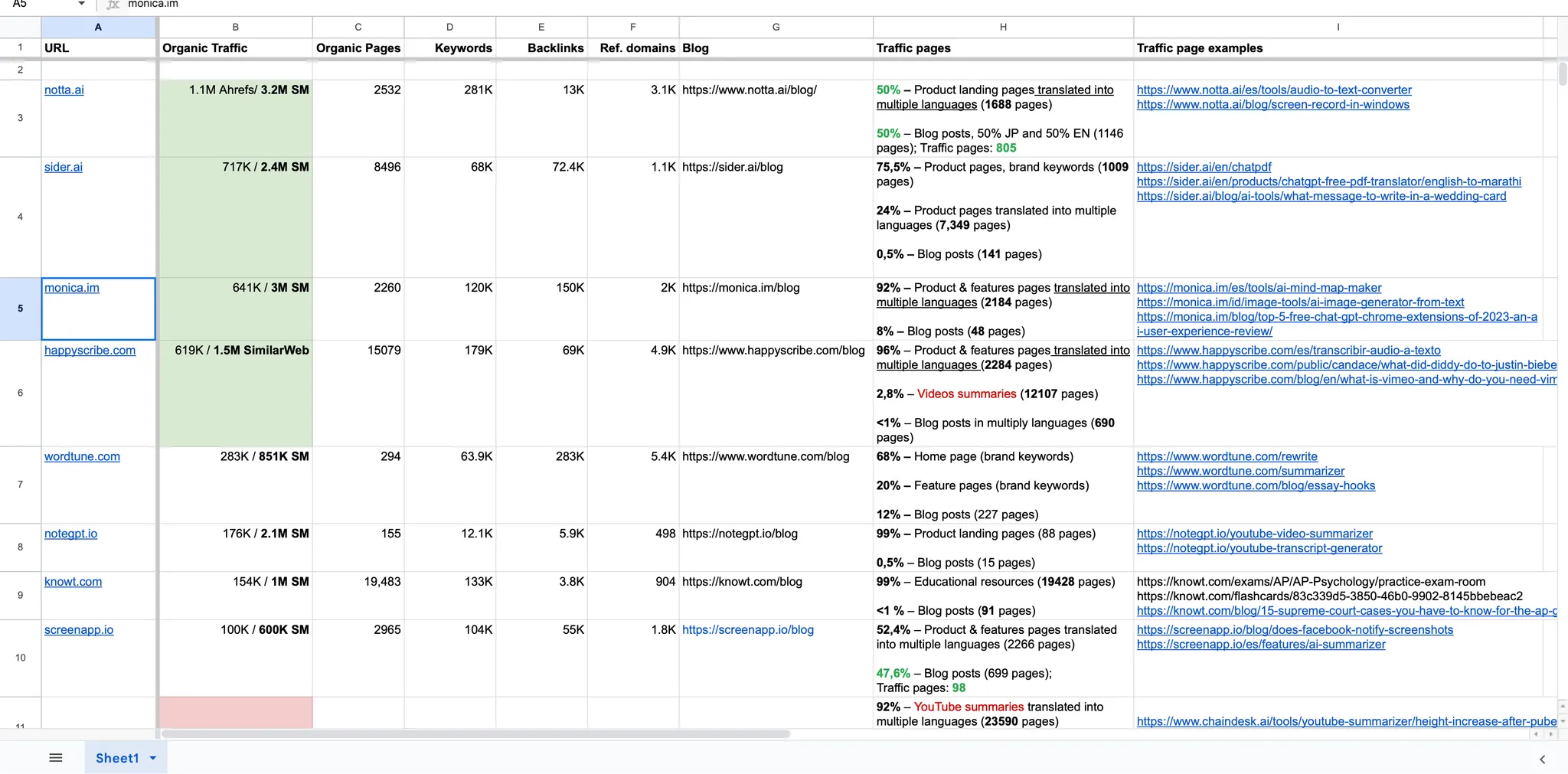
Our competitor research revealed three key types of pages generating organic traffic:
- Product Pages (landing pages)
- Focused on specific features/tools
- Only effective with full SEO optimization
- Work better when linked to content pages or AI tools
- Sites with landing pages alone rarely rank high
- Content Pages
- Blogs, articles, tutorials, guides
- Only a few competitors get significant traffic
- Most show poor results
- Blogs, articles, tutorials, guides
- Free AI Tools
- Most effective and fastest-growing category
- Breaking down main product into micro-features or creating simple tools for existing search demand
- Separate optimized page for each feature
- Examples: PDF summary, title generation, content ideas
Our Strategy:
Beyond competitor analysis, we studied Google’s recent updates and new search strategy. Simply put, Google now prioritizes sites that are most useful to users and effectively solve their problems. The key shift is from merely satisfying information needs (finding information or functionality) to directly solving user problems.
For example, instead of ranking well-optimized pages with “Sign up” or “Buy now” CTAs highly, Google now favors pages offering free tools – especially those without registration requirements.
So our strategy was simple – make all features free, unlimited, and registration-free for the first few months to help Google promote us.
Key points:
- Focus on free AI tool pages
- Offer free product access on commercial pages
- No monetization until reaching 30,000 monthly visitors
- Test quality longform content
- Target high-traffic potential topics with low competition
The strategy worked: we grew from 426 visits in our first week to about 26,700 weekly visits when I’m writing this – a 62.7 increase in weekly traffic.
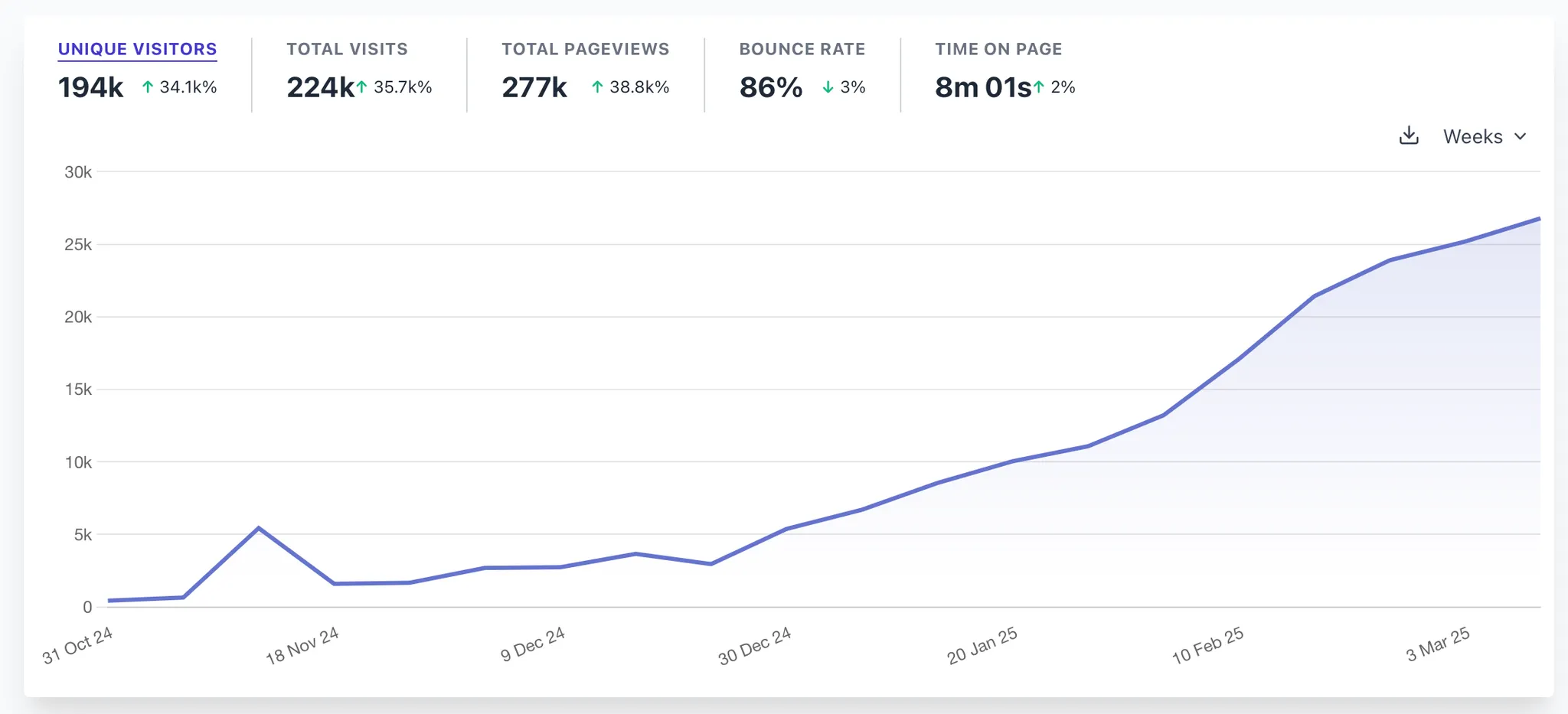
Here’s how we’ve grown in terms of the number of ranked keywords

Technical Implementation:
While many SEO experts claim technical site optimization is crucial, I disagree. From my experience, if you build a decent website, you don’t need to obsess over technical optimization.
Our site consists of two technically distinct parts:
- Main Product Pages Built with our custom engine. This was the optimal choice because we could reuse existing components, layout, and design from our main site, just changing text and colors. Plus, we needed to let visitors use our main product directly on the site, so using our existing solution made the most sense.
- AI Tools and Blog Pages Here we faced a different challenge – optimizing developer time. With our expensive development team, using their time for publishing articles or building multiple landing pages wasn’t cost-effective. We chose WordPress + Impreza theme and Page Builder so our marketing project manager could create pages independently. We deployed WordPress on a subdomain and set up proxying to the main site. This solution saved significant development resources and gave us more flexibility for site management and experimentation.
The most important aspect of technical optimization is achieving high speed and good PageSpeed Insights scores. We achieved page load scores of 83-99, which is excellent.
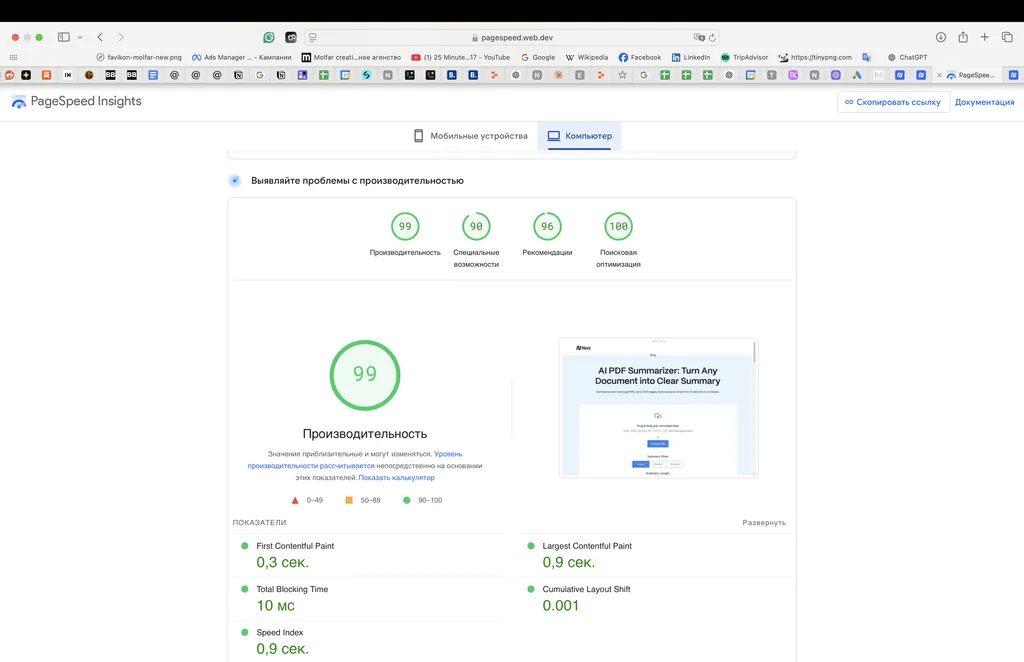
🔍 Content Strategy
The main challenge with blog content is extreme market competition. Every worthwhile topic already has content, often either exceptional quality or from major media outlets like Forbes and BBC (or both), making competition nearly impossible.
Content is essentially a Red Ocean, where creating something truly new is challenging. Yet you need to generate large volumes of content targeting many low-volume keywords to get even minimal organic traffic.
Quality content requires significant investment and doesn’t show desired ROI in our niche. Still, we decided to test this approach since it worked for some competitors.
We decided to abandon AI content generation because Google has been actively fighting against such content in recent core-updates. We conducted several experiments that showed while generating large amounts of AI content might produce short-term results, it would likely lead to penalties that Google imposes on the main domain. Therefore, for projects operating in white-hat niches, AI-generated content is far from the best choice. That’s why we made the decision to create content using human writers.
To determine our content strategy, we analyzed four competitors successfully getting search traffic through content. Our deep analysis collected data on all articles:
- Traffic volume
- Main keyword
- Current SERP position
- Keyword difficulty (Ahrefs metric showing backlinks needed for top rankings)
For each article, we evaluated:
- Competition level (presence of domains with lower DR than ours in top-10)
- Traffic relevance to our product (cold/warm/hot)
- Keyword’s global potential (maximum possible traffic)
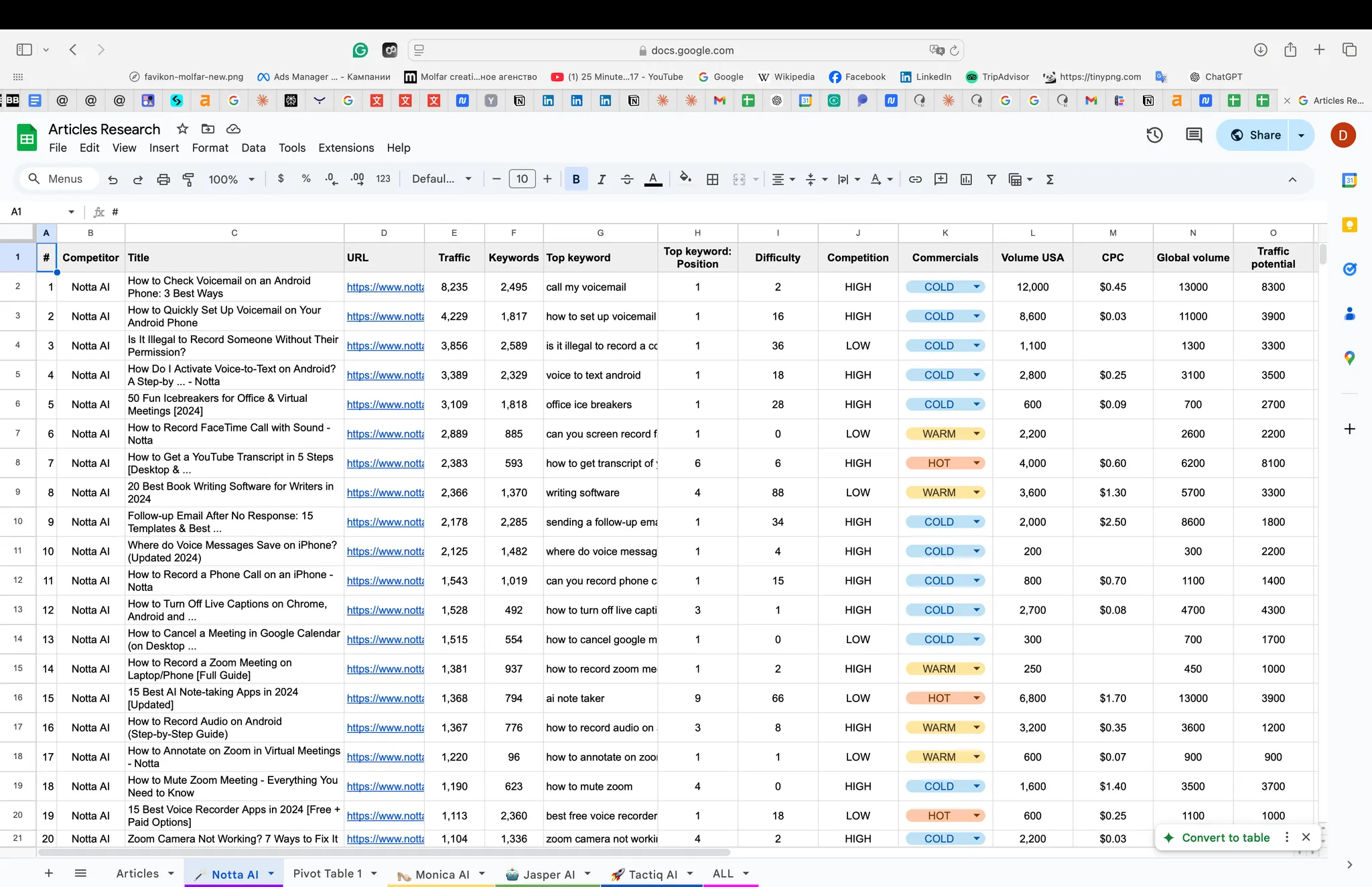
Using pivot tables, we filtered competitors’ articles to find 50 topics that:
- Have low competition
- Bring targeted traffic
- Don’t require many backlinks
We selected 26 articles for testing and built keyword clusters for them.
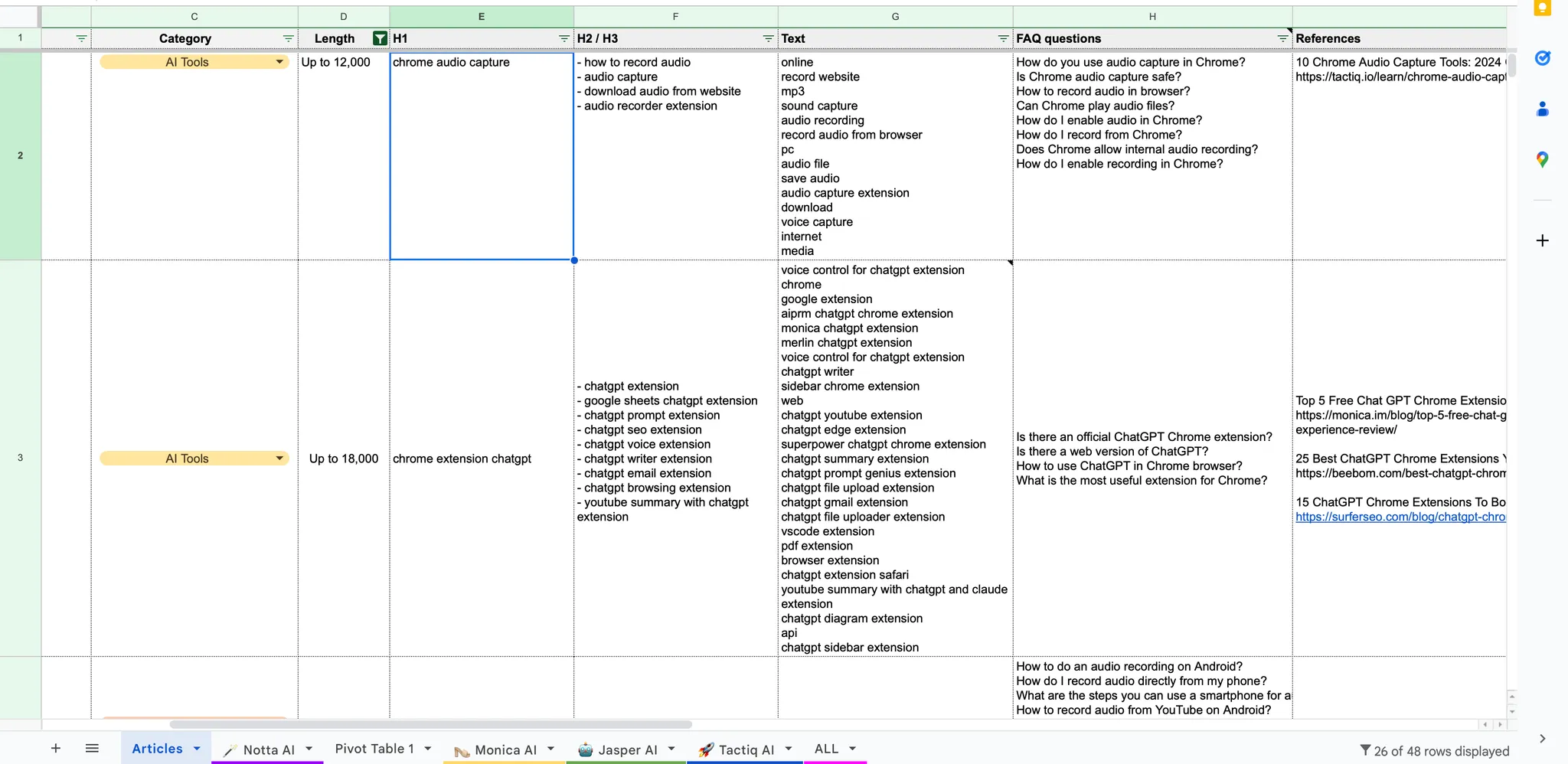
We tested three writing teams, each tasked with creating three articles:
- South African freelancer: $0.05 per word
- Ukrainian agency #1: ~$31 per 1000 characters
- Ukrainian agency #2: Initially $7.1 per 1000 characters, increased to $10.7 due to complexity (AI tool testing, trial accounts, review analysis)
Each writer received detailed instructions:
- Company, product, and target audience brief
- Comprehensive content requirements
- Specific guidelines for each article
We spent $1,573 on test articles, getting 9 longread pieces and choosing our content partner.
For blog design, we used Midjourney + Claude for prompt generation, achieving consistent visuals. We tweaked covers in Figma to reduce AI detection likelihood.
Over two months, we ordered 26 more articles (~425,000 characters) for $4,530.
Total content investment: $6,103
The blog brought 3,900 unique visitors. Traffic is growing 26.3x from first to current week, though slower than free AI tool pages. Average time on page is 5 minutes, showing good engagement.
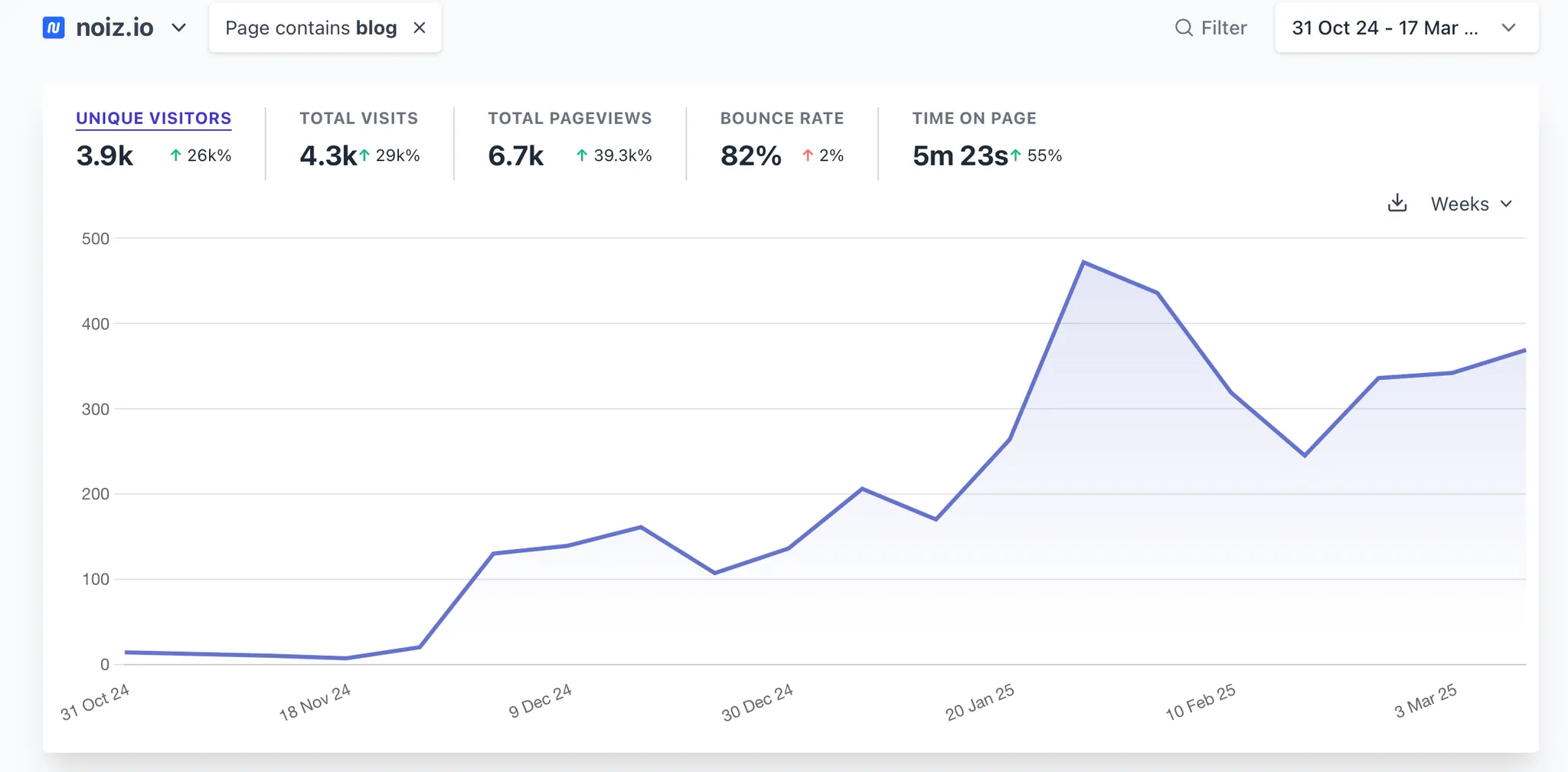
Despite decent results, blogging is a long-term investment. It’s worth pursuing only if you can build a trustable writing team to reduce per-character costs and commit to months of investment. Then you can build a strong corporate-media generating significant traffic.
🧰 Building Free AI Tools
To attract and retain users, we developed 15 free AI tools related to video summarization and productivity. These tools were built without any programming knowledge, utilizing no-code platforms to expedite development.
Our key hypothesis was to create completely free AI tools that solve user problems – unlike most competitors who require registration or payment. We made them free, unlimited, anonymous, and registration-free. We believed search engines would value this user-first approach and promote our site since it offers a more convenient and effective solution.
We analyzed 11 companies successfully promoting through free AI tools. We scraped data from all competitor pages offering IT tools. The analysis was extensive – our largest competitor had 7,635 pages, with others averaging 500-1,000.
We included these parameters:
- Page title
- URL
- Organic traffic
- Number of ranking keywords
- Main keyword
- Country where the main keyword ranks best
- Current SERP position
- Search volume (US and global)
- Traffic potential for #1 position
During data processing, we identified page languages (language versions) and tool names, then classified them functionally. For example, the “translators” category included PDF translators, image translators, and standard text translators.
We created detailed tables with comprehensive data for each competitor.
After data collection, we began in-depth analysis. Using pivot tables, we studied each competitor to understand traffic distribution between specific tools and categories. We also analyzed page distribution – how many landing pages competitors create per tool, including different language versions and positioning pages (same tool presented for different audiences or optimized for different keywords).
We then assessed each tool’s potential by search volume, analyzed average positions for main keywords, and calculated potential traffic for individual tools and categories. We did this analysis for all competitors.
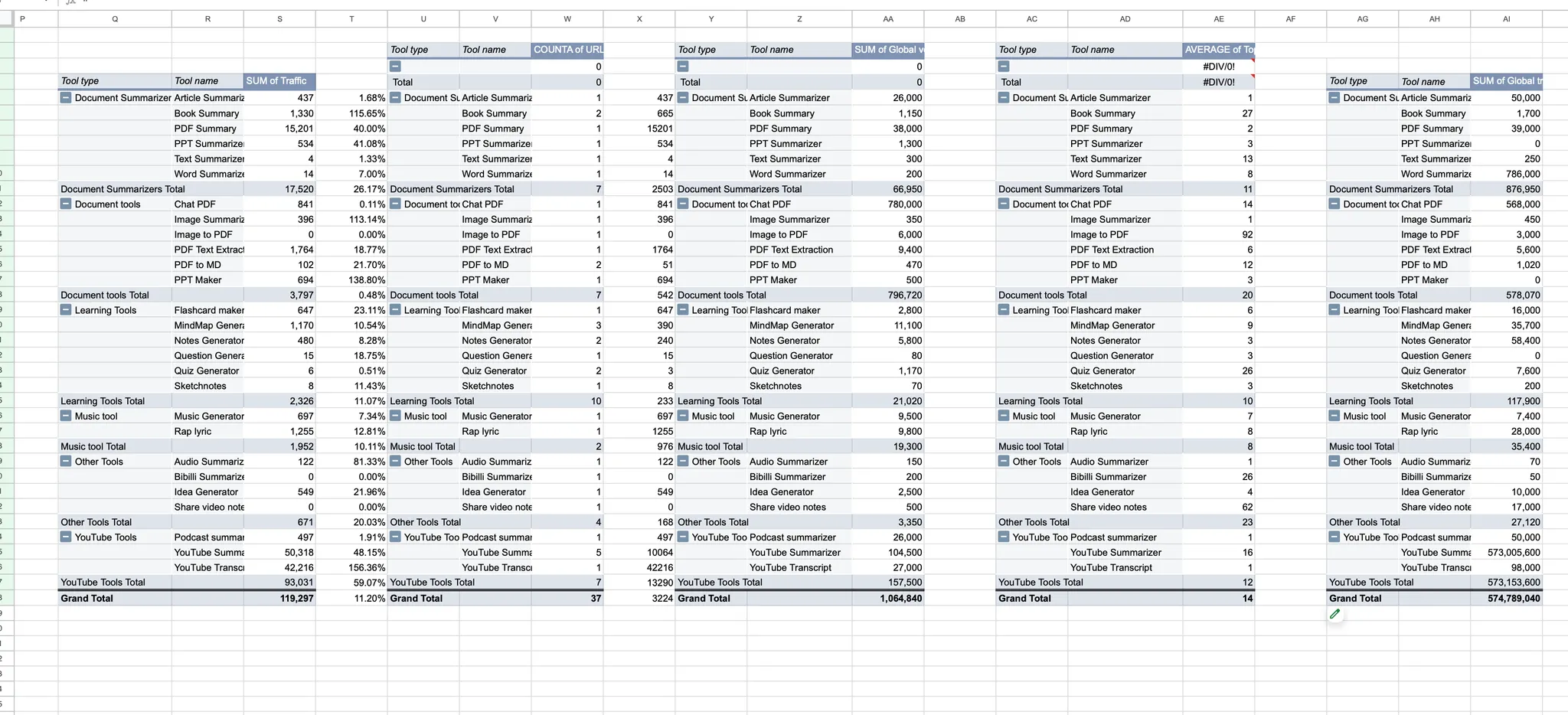
After that, we selected 40 potential tools for detailed analysis. We analyzed each tool based on the following parameters:
- Keyword Difficulty – number of backlinks needed to rank
- Competition – presence of domains with lower domain rating than ours in search results
- Global Volume – overall search volume
- Traffic Potential – estimated traffic we could get from ranking #1
- Top Competitor Analysis:
- #1 ranked site’s traffic and backlink profile
- #10 ranked site’s traffic and backlink profile
- Target Audience – who would be interested in this tool and their relevance to us
- Technical Complexity – development effort required for widget creation, considering whether we need developer resources or can handle it without using developers.
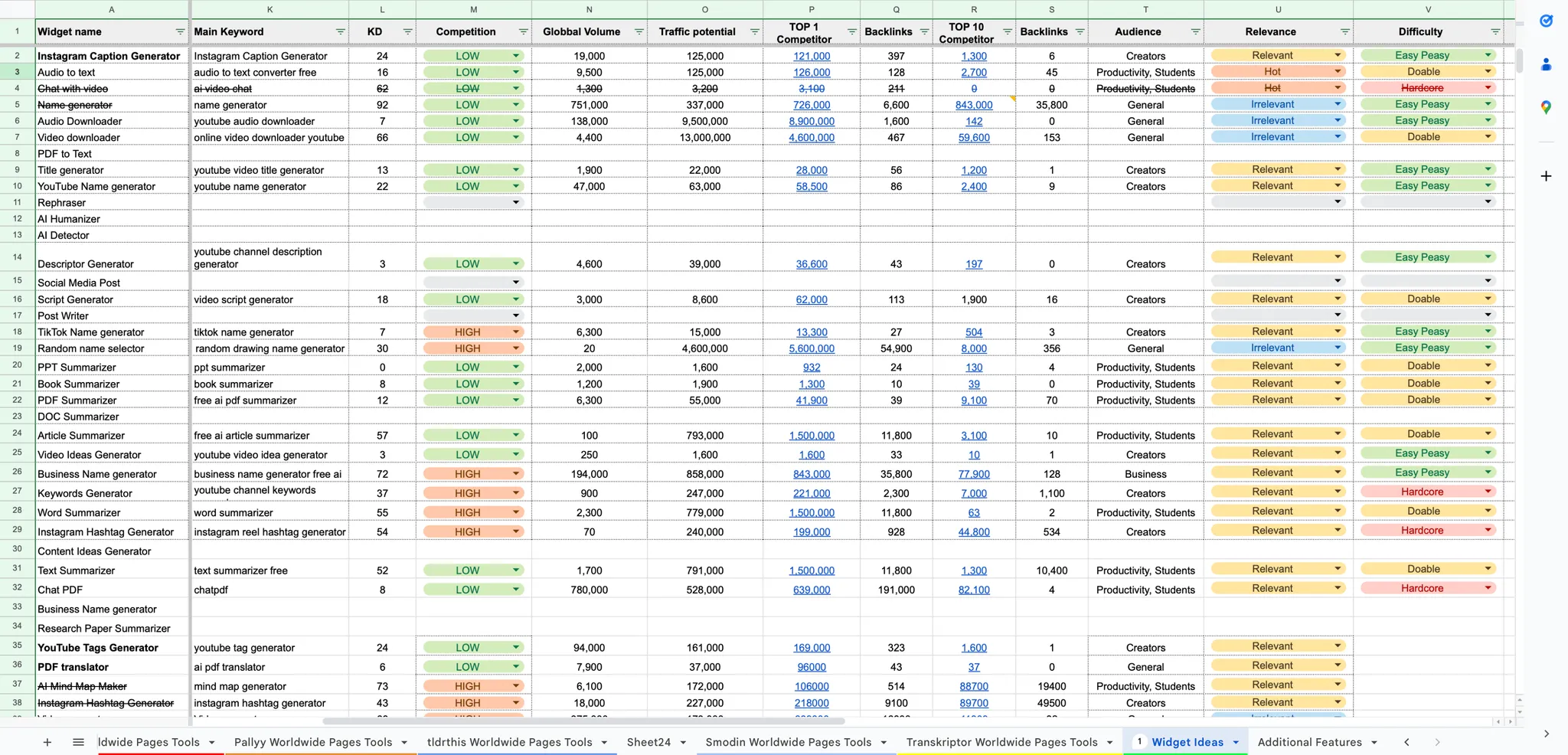
The resulting table helped us identify the most promising tools.
As a result, we created 19 original tools that can be divided into two categories: marketing/content creation tools and education/productivity tools.
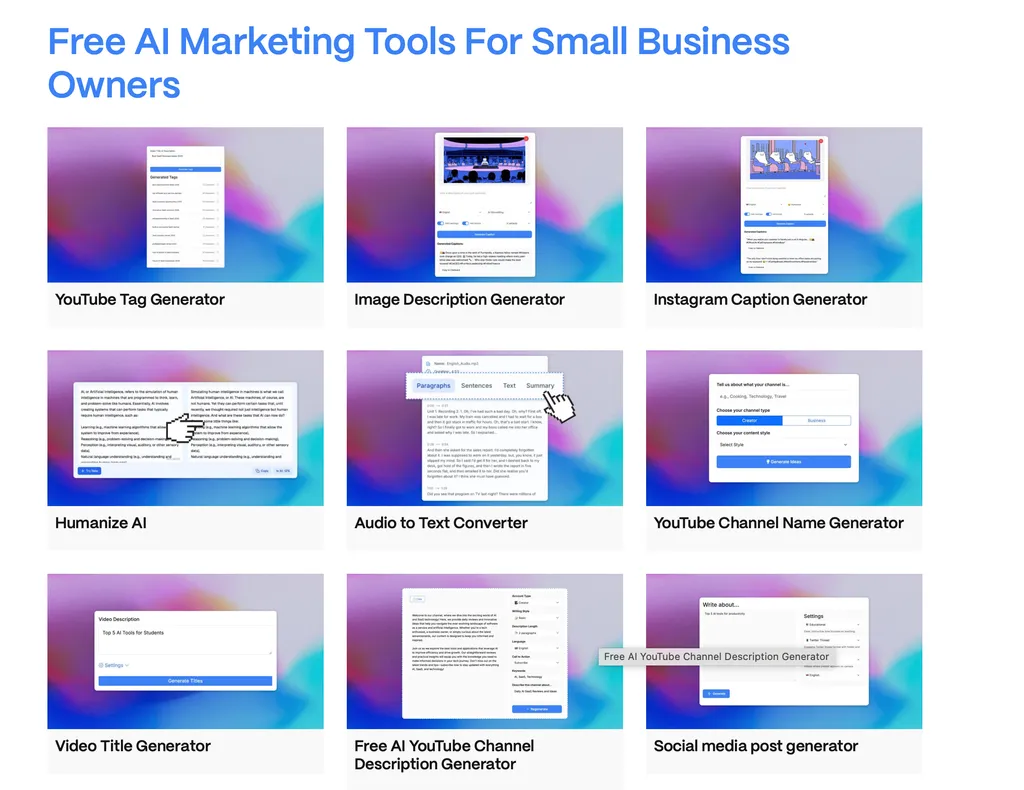
Diego and the team personally developed 15 of these tools using Replit without any skills in programming. For the remaining 4, we brought in a developer since they were more complex. For example, the PDF chat tool required proper PDF search configuration to get cost-effective user responses while avoiding LLM hallucinations – it was faster and cheaper to have a developer handle this. We also use our a developers for the audio-to-text tool to optimize transcription costs and select the right API, as it was more efficient than doing it myself.
Additionally, rather than developing complex tools ourselves before validating demand, we utilized third-party APIs. We essentially purchased ready-made solutions, as we did with the AI detector and AI humanizer. These two tools require sophisticated development to accurately identify AI-generated text and rewrite it effectively. The simplest solution was to use existing tools by purchasing API access and paying for token usage. I developed all remaining tools independently, except for these four mentioned cases.
How to Build AI Tools Without Programming Knowledge:
Creating simple AI tools today doesn’t require programming skills, except for complex tools needing extensive functionality, databases, and specific load/security requirements. Anyone can create basic applications. There are specialized AI tools that can program for you based on text descriptions. The two most popular ones are Cursor and Replit.
Cursor is more complex and comprehensive, positioning itself as a developer’s assistant. Replit targets non-programmers, letting them create web applications and immediately use the platform as hosting to attract initial users.
I chose Replit for its simplicity – it helps select technologies and develops required functionality. When errors occur, you can screenshot them and send them to chat for automatic fixes.
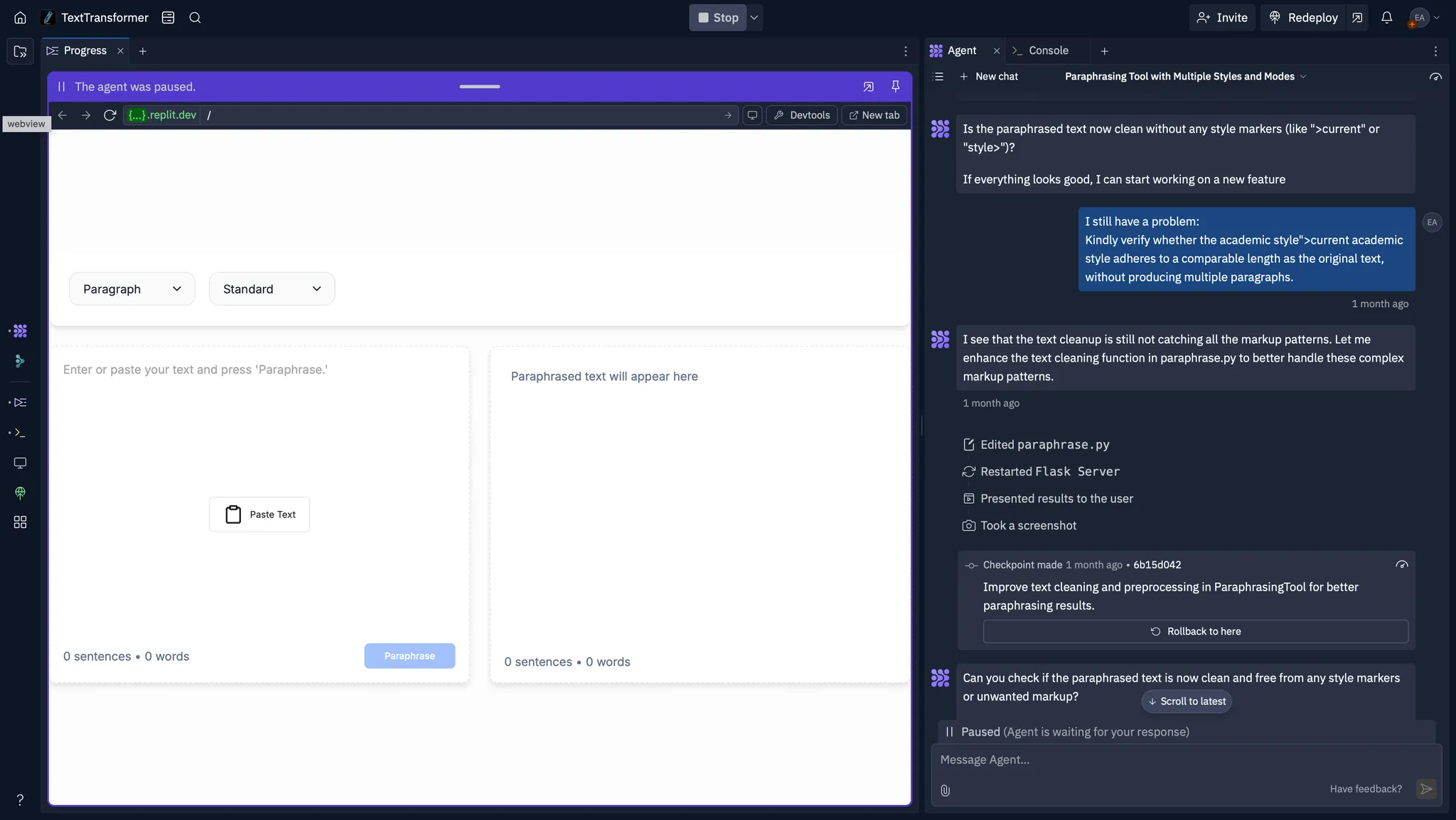
The development process is straightforward: you describe your project to AI, which creates a prototype, stopping at each iteration for review and comments. Creating one tool takes up to two days, resulting in a fully functional solution with desired design, embeddable via iframe.
For AI tools, I used Flask for backend, standard HTML, CSS, and JavaScript for frontend, ensuring consistent branding across all solutions.
When Replit couldn’t handle a task independently, I turned to other AI models. I’d send them problematic code and error descriptions, asking either to find the issue or optimize the code for proper functionality. This approach proved effective and allowed me to develop almost any application without deep code understanding or programming language knowledge.
Our approach to creating AI Tools was straightforward. We identified the top 3 competitors ranking in search results and analyzed their functionality – which features were paid, free, or required registration. We then took their best features and made them completely free in our design. Essentially, what users could only get from competitors through paid subscriptions or registration, we provided completely free, unlimited, and without any registration requirement, maximizing value for the user.
We can afford this because modern AI technologies allow a single person with no programming knowledge to complete in just a few days what previously required a seasoned developer and significant time investment.
📊Creating Our Landing Pages
Creating landing pages is a separate process that requires resources and often falls on developers’ shoulders. We didn’t want to make this process more expensive – instead, we aimed to optimize it as much as possible. To achieve this, we landed on a combination of WordPress and AI for content creation.
I created an optimal structure for the first lining, prepared all templates in Figma, and then transferred knowledge about all landing pages to our marketing project manager. He managed to handle everything independently, without any programming knowledge, development skills, or anything else. Let me walk you through how this process worked, step by step.
Step 1. Keyword Research
We use Ahrefs to determine optimal keywords for each niche. The process starts by entering the main keyword into Keyword Explorer.
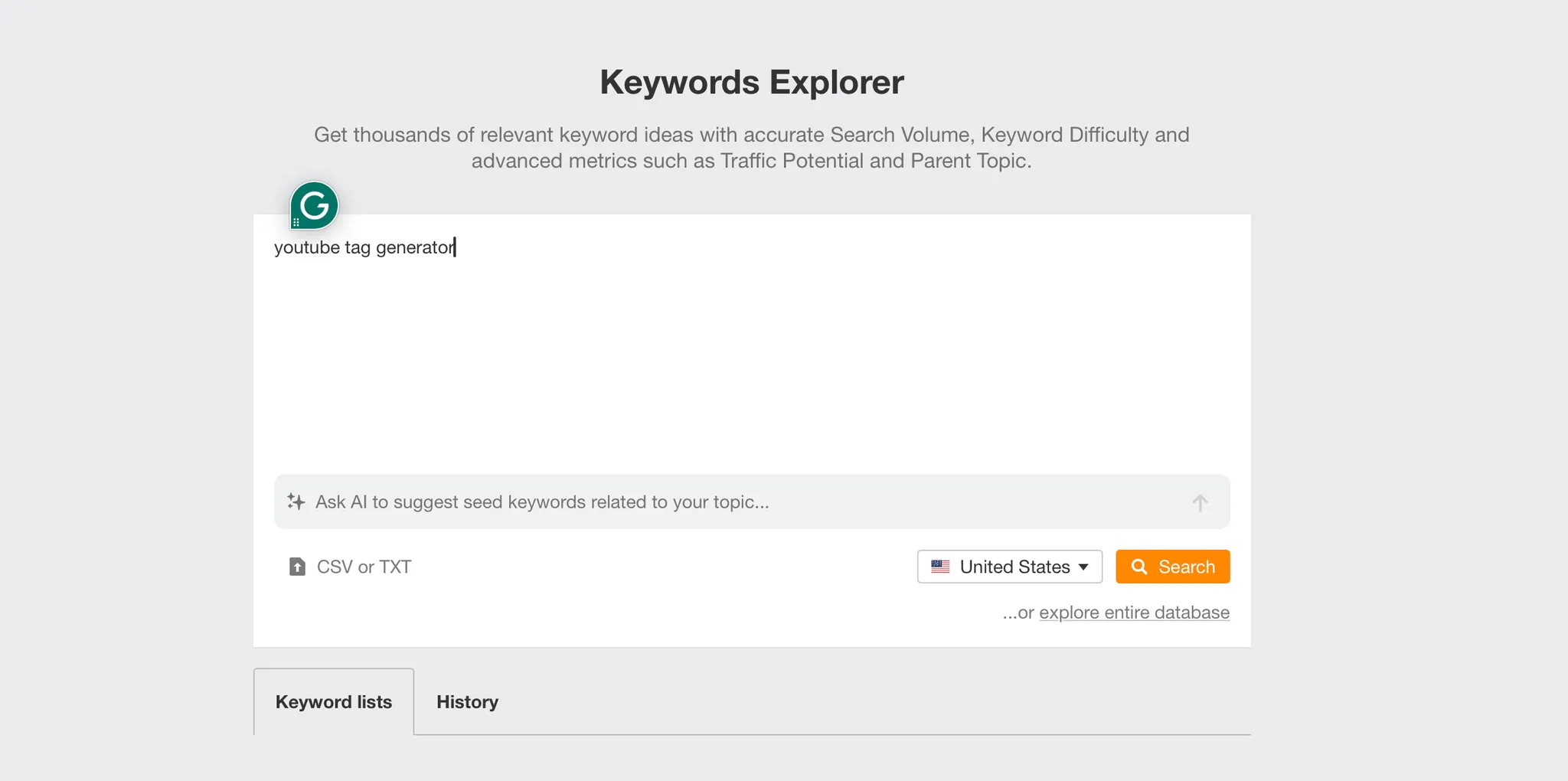
This gives us detailed analytics about the keyword, including top-ranking competitors.
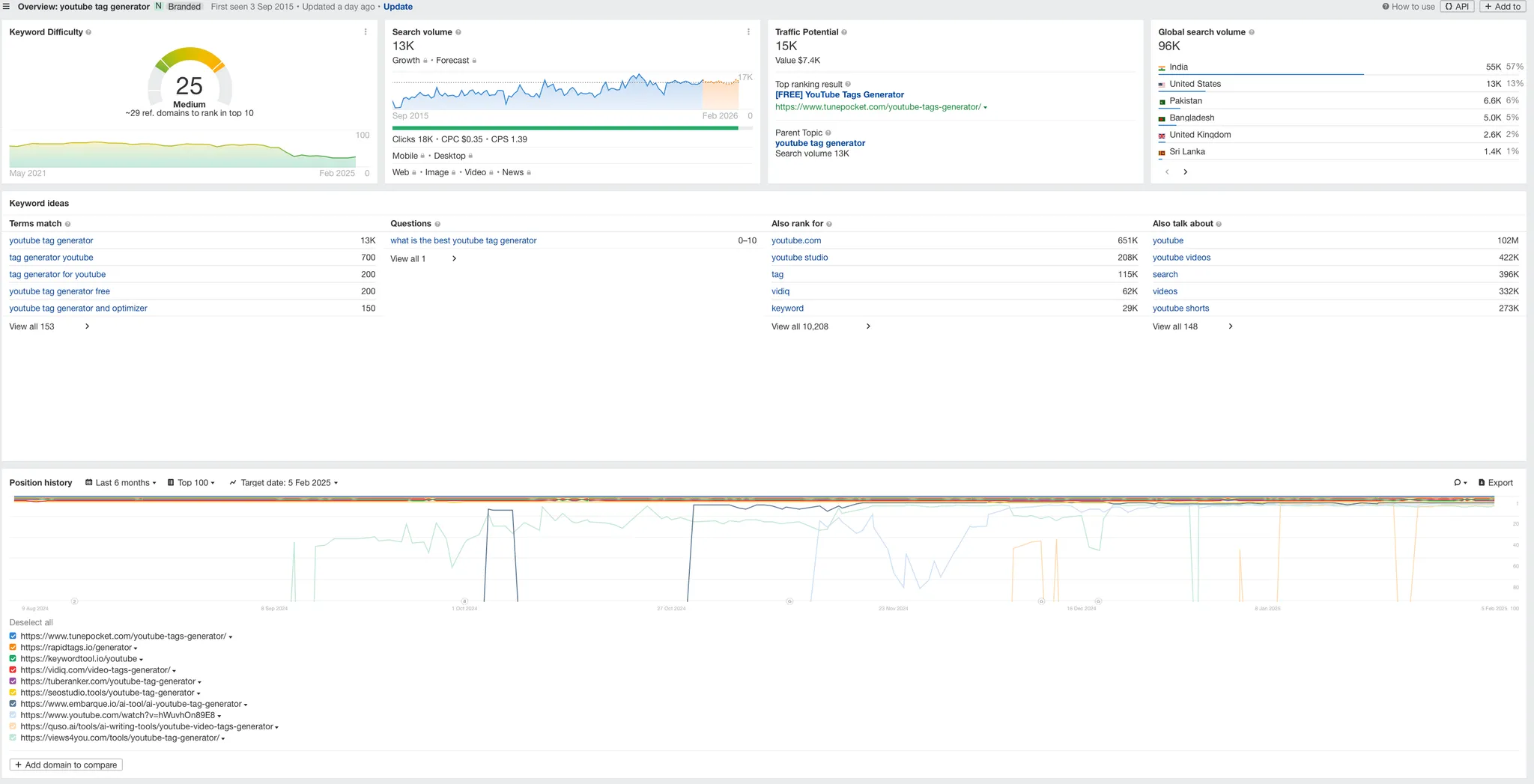
Next, we go to Keyword Ideas, click View All, and get a complete list of keywords relevant to our main keyword for deeper research.
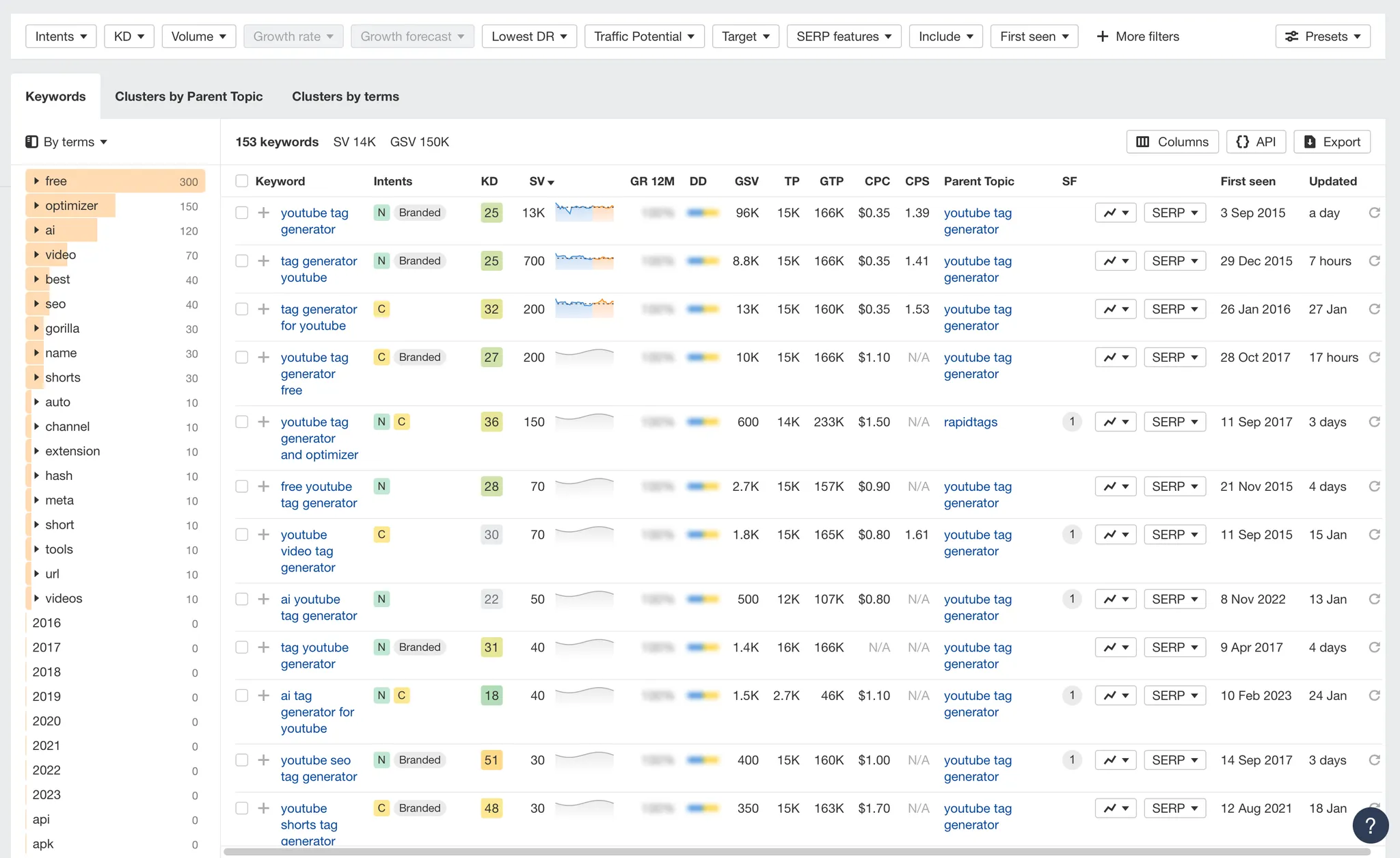
We export these keywords to a spreadsheet. When there are multiple main keyword variants, we either conduct multiple research rounds or analyze competitor pages to build a comprehensive keyword set. We then consolidate all keywords into one document, remove unnecessary information, and keep only crucial metrics: Keyword Difficulty, Global Search Volume, and Global Traffic Potential. These parameters help determine each keyword’s role in our strategy.
The result is a table with essential information. Then we analyze questions for the FAQ section.
There are two main methods for finding common user questions. First, use Ahrefs’ dedicated section showing relevant questions for a given keyword. However, from my experience, it’s more effective to simply go to Google, enter the keyword, and analyze search suggestions and questions Google considers relevant for users.
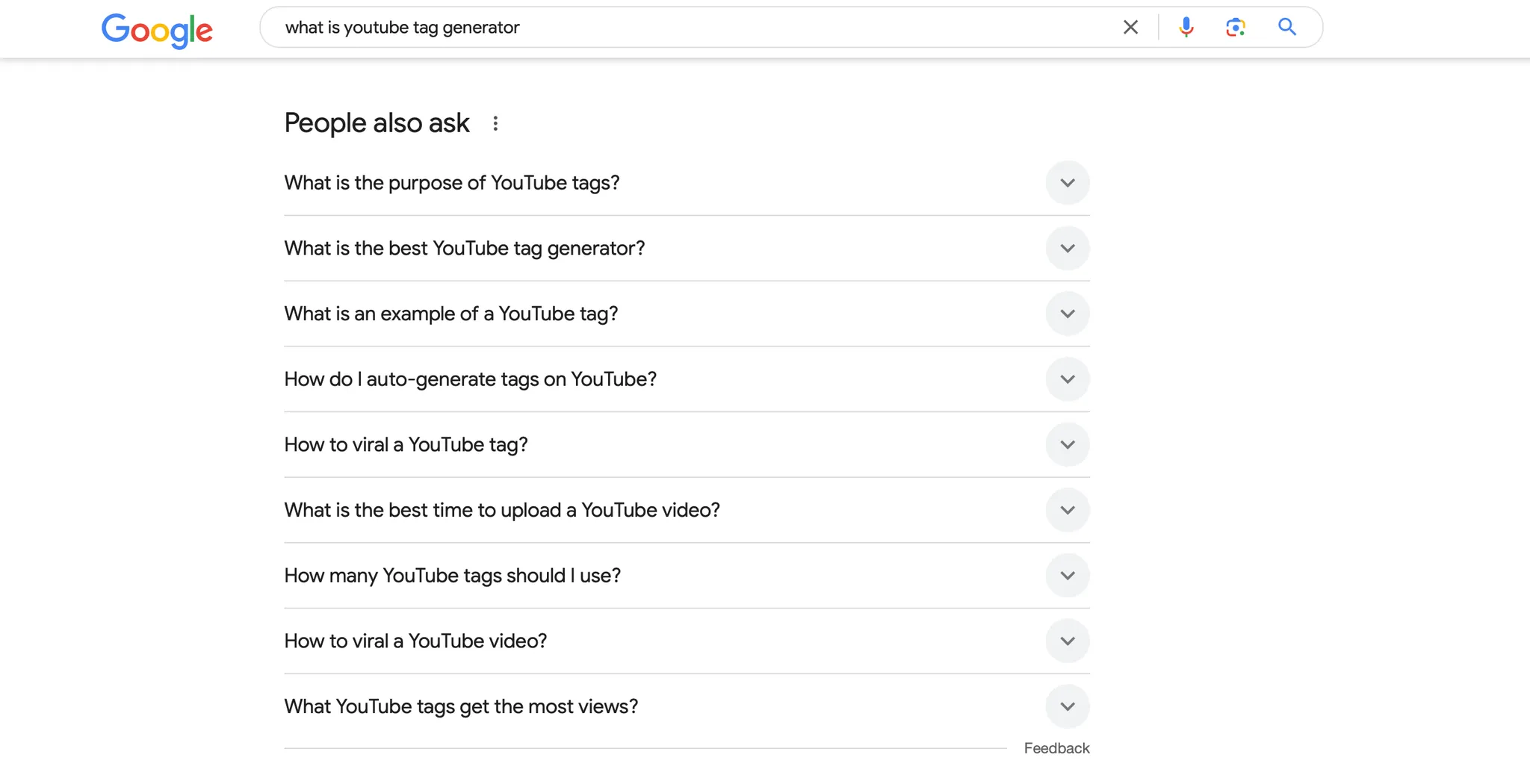
Step 2: Writing Content
After keyword research, we need to create content for the landing page. We use Claude Sonnet 3.5 as the highest quality model for content generation. We use a specially developed prompt for creating quality texts.
This produces decent content, which we check for AI detection and plagiarism using Grammarly.
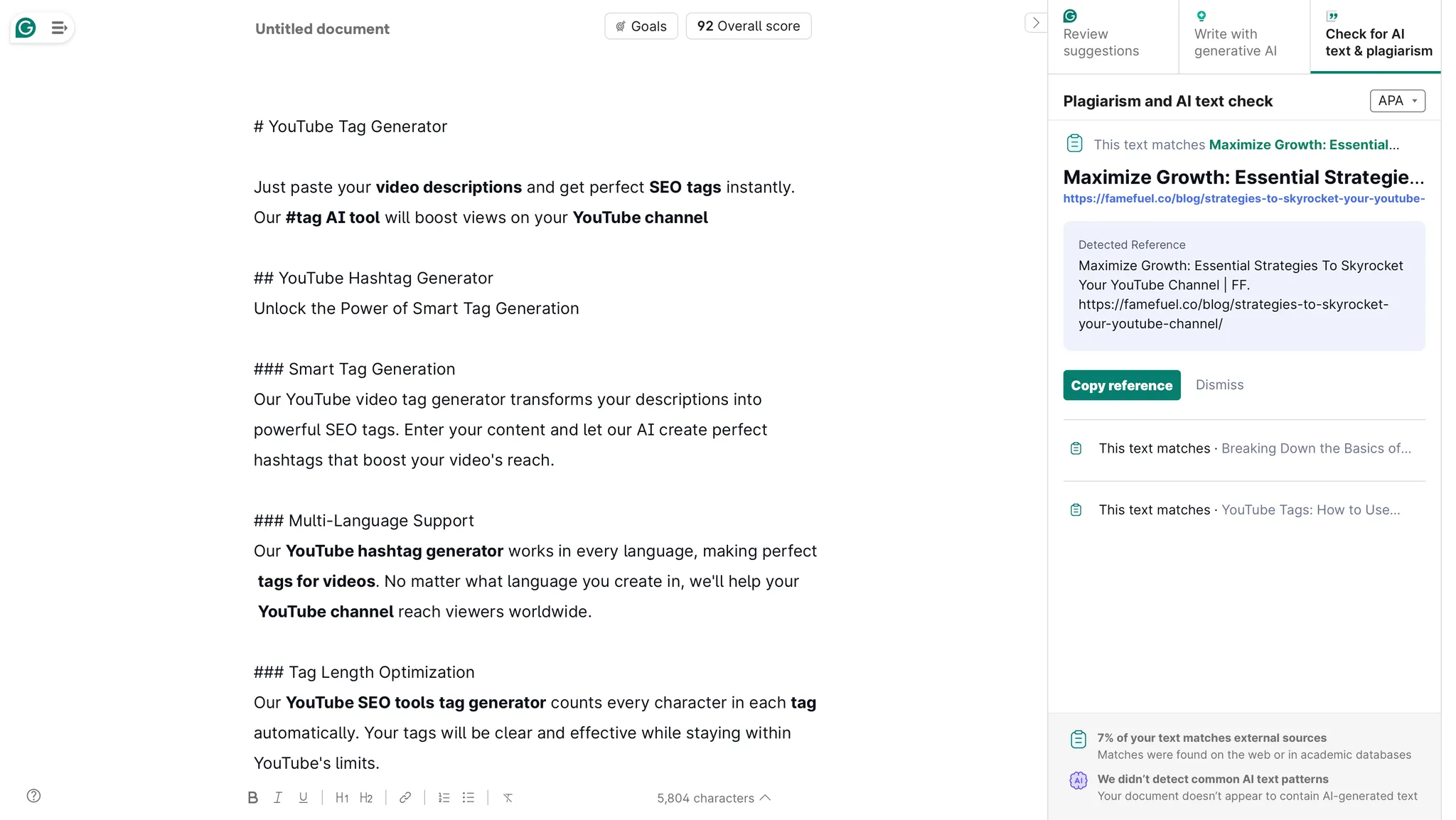
If the detector shows more than 15% AI-generated text, we rewrite those parts to achieve a high level of “human-like” content.
In the same AI we create title and description for a page. For this, we use the next prompt.
- Page Design and Layout
We use WordPress with the Elementor theme and Page Builder drag-and-drop constructor as our visual shell. This gives us two key advantages:
- Ability to use ready-made templates and configure design elements once, then transfer them between pages
- Create new landings using simple visual blocks that anyone can manage without programming skills – just dragging, adding, removing, and configuring elements
This approach allows us to create pages quickly.
Besides writing text, AI helps us select section icons through Font Awesome. AI recommends appropriate icons, we just copy their names into the editor and get the visual block.
The only component requiring manual work is the screenshot block. We have a clear template and instructions for creating these screenshots. Following these instructions, the Project Manager spends 30-40 minutes creating all necessary visual content.
During the first months, our customer provided unlimited access to their key product – YouTube Video Summarizer. Any user could simply visit the homepage, paste a YouTube video link, and get its summary in just 10 seconds.
This strategy proved highly effective, as we quickly gained rankings for our targeted keywords. User engagement metrics were strong, with average time on page exceeding 10 minutes. Users actively navigated between pages, demonstrating high engagement levels.

Google recognized the user value we were creating and rewarded our site with improved rankings accordingly. In the last 30 days, we’ve generated slightly over 102,000 visits, with continued growth. Next month, we project reaching approximately 150,000 visits to these pages.
🔗 Link-Building Tactics
We employed effective link-building tactics, including guest posting and outreach to industry-specific directories, to enhance our site’s authority.
This resulted in acquiring high-value backlinks at a fraction of the typical cost.
To successfully promote a website in search engines, it’s crucial to show that your content is valuable beyond search results.
We faced two key challenges:
- Changing our site’s topical category in Google
- Previous category: audio applications (relaxation sounds)
- Target category: video applications
- Demonstrating external content demand
We used two main approaches:
- Link building: strategically acquiring quality external links (this article is part of our strategy)
- Generating brand traffic through social media using our in-house micro-influencers to create Noiz content
- This increased branded search queries
- Increased direct site visits
Link Building:
We used three main strategies for quality link acquisition:
Strategy One – Placement in AI Catalogs and Tool Aggregators
Our Project Manager directly purchased placements in major paid catalogs. We analyzed catalogs and selected the best and most premium ones for placement.
For mass placement in free catalogs, we hired a specialized company that placed us on 120 relevant platforms for $300.
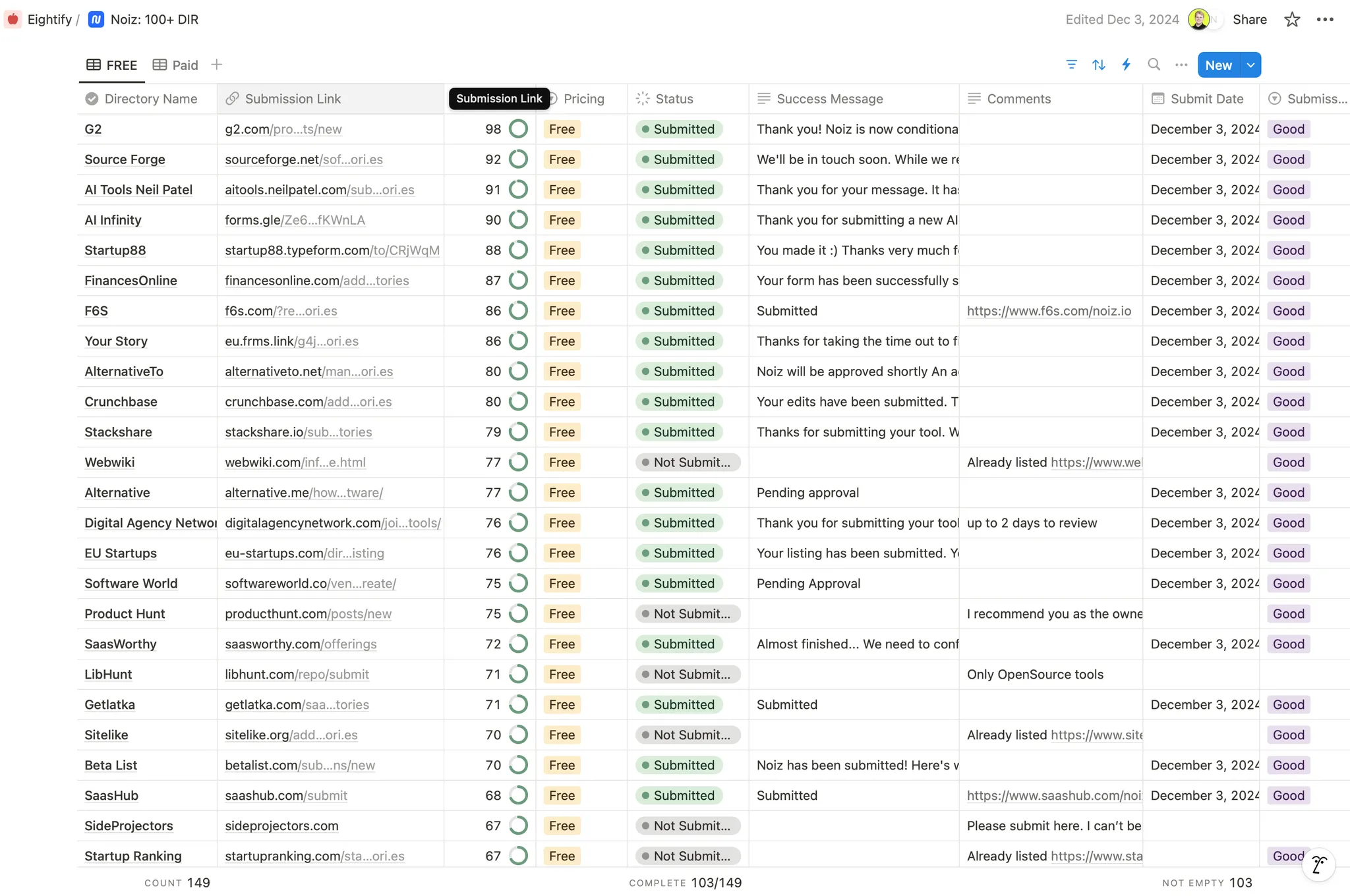
Important note about catalog placements: this tool requires a careful approach. Mass placement in irrelevant catalogs can confuse search engines because categories won’t match your product. Google easily detects artificial link buying, which negatively impacts rankings.
For maximum effectiveness, you must:
- Place only in targeted catalogs within your product category
- Create quality descriptions
- Provide complete and accurate product information
We spent $1,085 on direct catalog placements and $300 on placements through the company.
Strategy Two – HARO (Help A Reporter Out)
Our second strategy was HARO, an effective method for getting quality backlinks well below their market value.
Here’s how it works: on specialized platforms, journalists and reporters look for experts to comment or specialists who can explain specific topics in detail. We actively responded to these requests, and as a result, journalists used our materials and linked to our brand. This approach yields high-quality links with minimal investment.
HARO requires significant time and operational complexity. We partnered with an agency we’d previously worked with on our main project to handle journalist responses on our behalf, now redirecting their efforts to promote Noiz.

Over several months, we secured 16 high-quality backlinks or brand mentions across major blogs and media outlets, with domain ratings from 59 to 94.
HARO is an excellent strategy that has allowed us to obtain backlinks worth tens of thousands of dollars (if purchased through marketplaces) for just $100-200. Here’s an example.
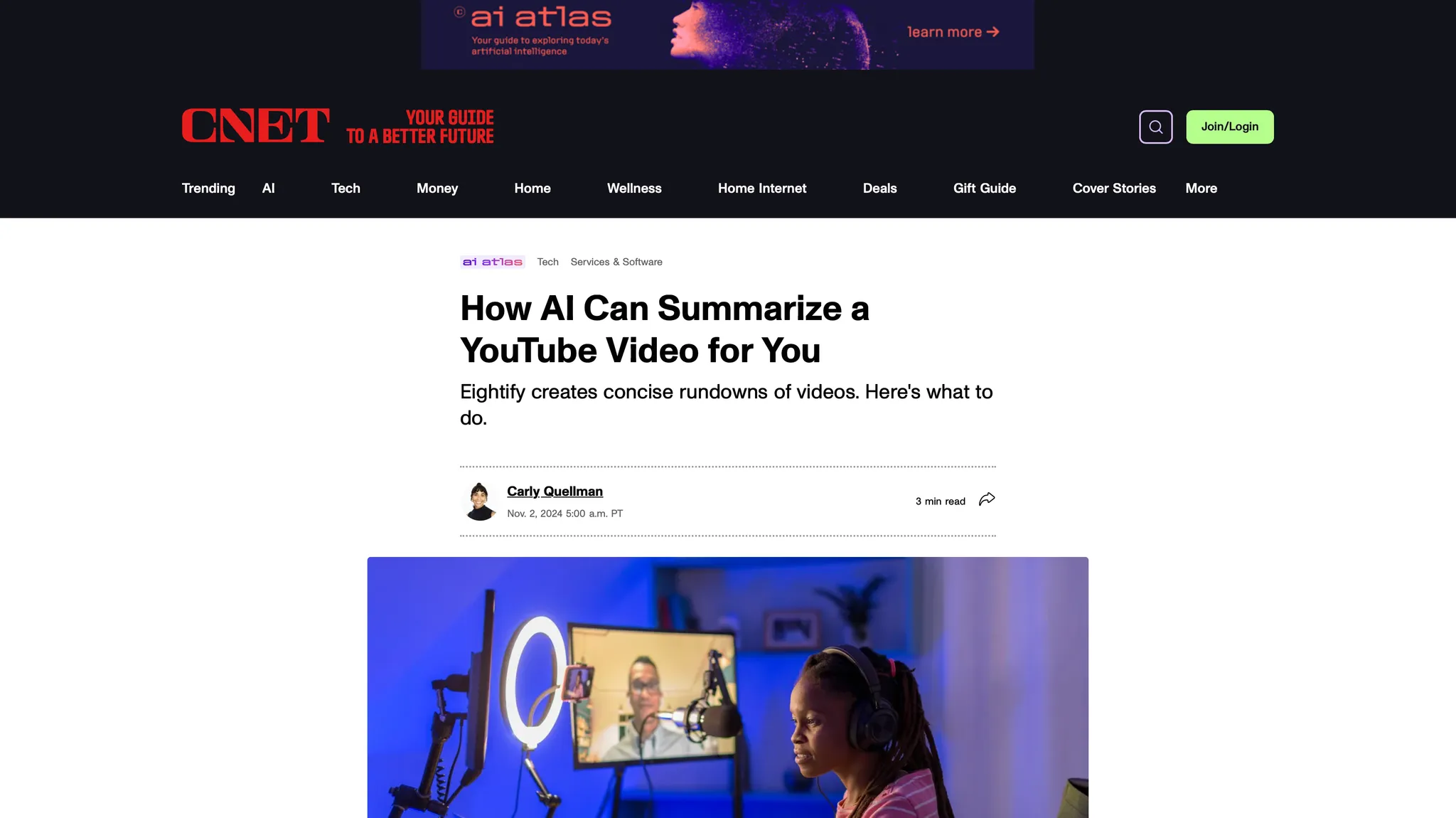
Over several months, we secured 16 high-quality backlinks or brand mentions across major blogs and media outlets, with domain ratings from 59 to 94.
HARO is an excellent strategy that has allowed us to obtain backlinks worth tens of thousands of dollars (if purchased through marketplaces) for just $100-200. Here’s an example.
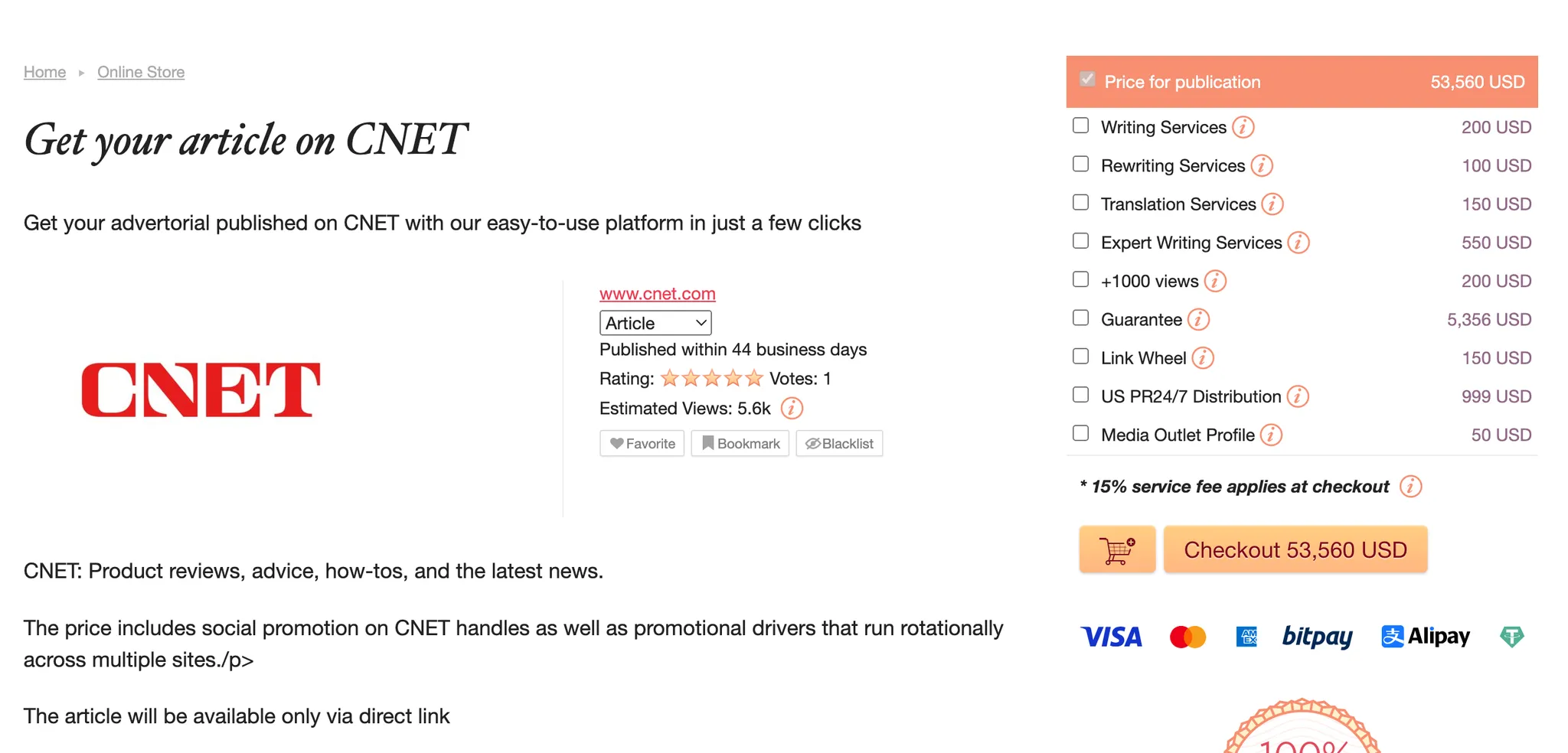
Total HARO spending over 3 months: $1,500.
Strategy Three – Classic Link Building:
We delegated our link building efforts to a part-time SEO manager. To compare placement conditions and secure optimal opportunities, we utilized platforms like PR News, Collaborator, and NeedMyLink.
We carefully selected relevant thematic media outlets and created quality expert content with links to our resource. In two months, we received 23 Dofollow links and spent $4,315 on placements.
Link Building Expenses:
Total spent – $7,200:
- $1,385 on catalog placements
- $1,500 on HARO
- $4,315 on classic link building
📣 Leveraging Micro-Influencers
We collaborated with micro-influencers to promote our tools, generating nearly 1 million views and boosting direct traffic significantly. This approach enhanced our brand visibility and drove user engagement.
Creating our own influencers is an experimental, guerrilla-style approach to promoting various applications and SaaS businesses. Here’s how it works: we have several models who regularly create short social media videos about our product.
Currently, we work with 4 models across Instagram, TikTok, and Snapchat. Each day, the models post 3 videos per social network, showcasing the product in various entertaining scenarios and highlighting its features.
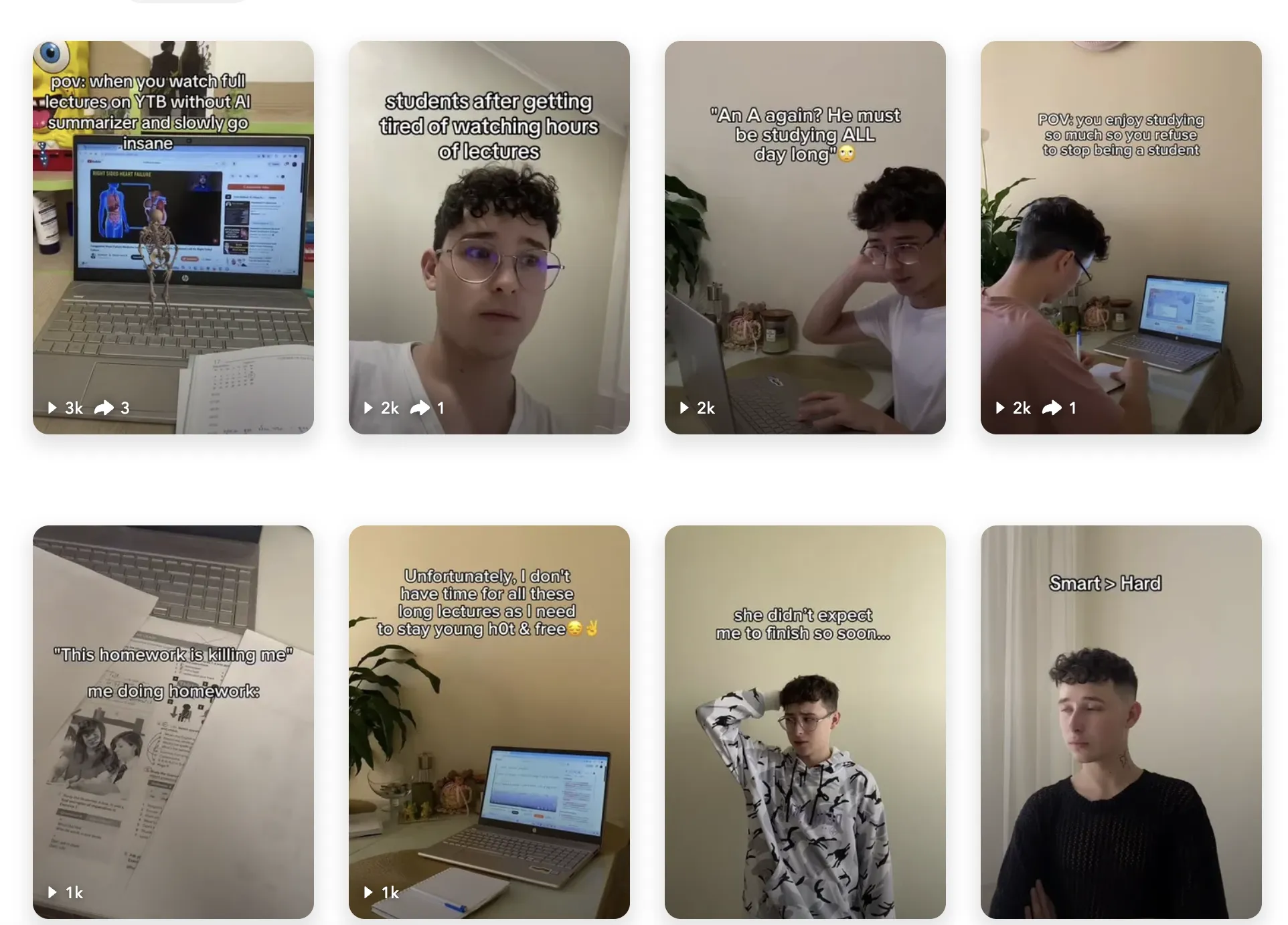
As a result, we’re seeing significant growth in branded traffic and direct visits. For example, here’s Ahrefs data showing the growth in branded searches for Noiz.
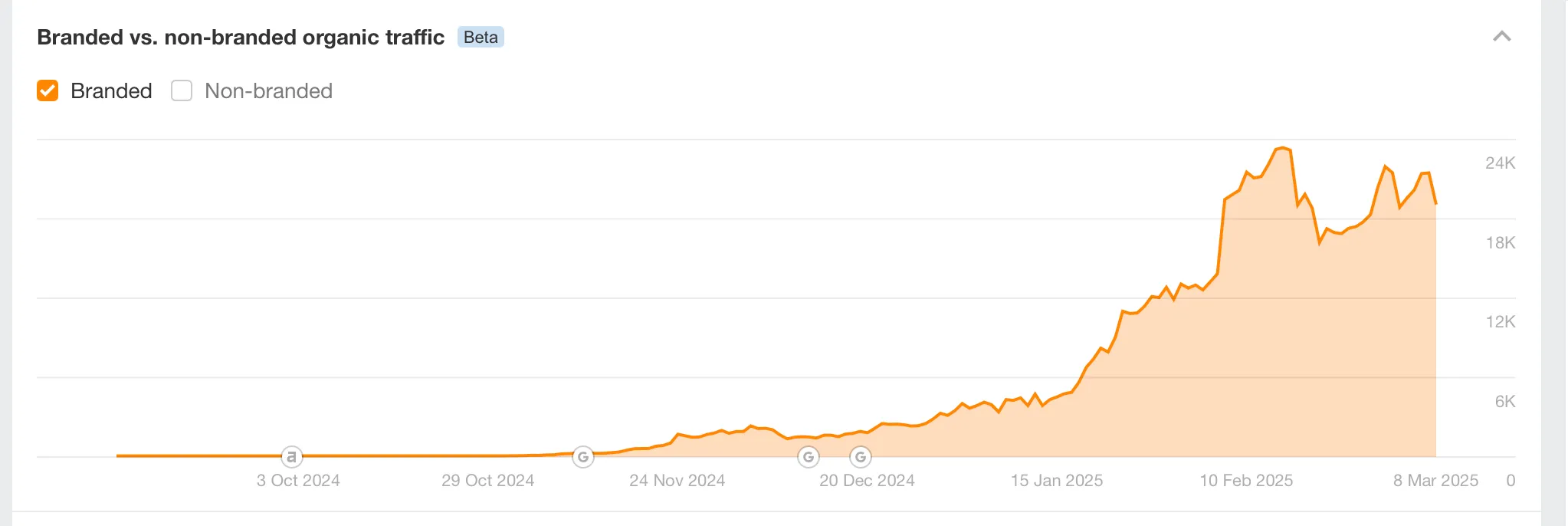
One more example, here’s data from Google Search Console showing how brand name searches have evolved over time.
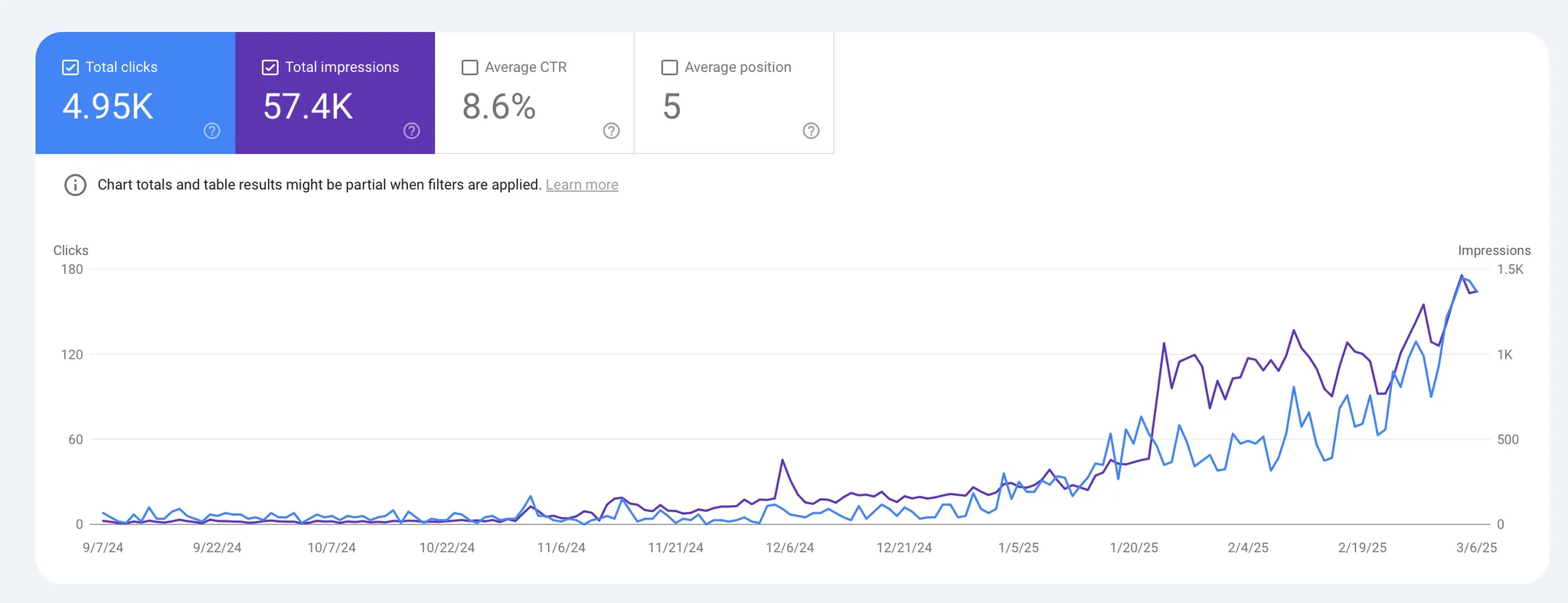
The most interesting observation is the increase in direct website visits. This pattern is particularly common with social media videos – users don’t search on Google, but instead type the website name directly into their browser. We’ve noticed a clear correlation: when we release a viral video that gains significant views, we see a corresponding spike in direct site visits. These spikes are clearly visible in the graph below.
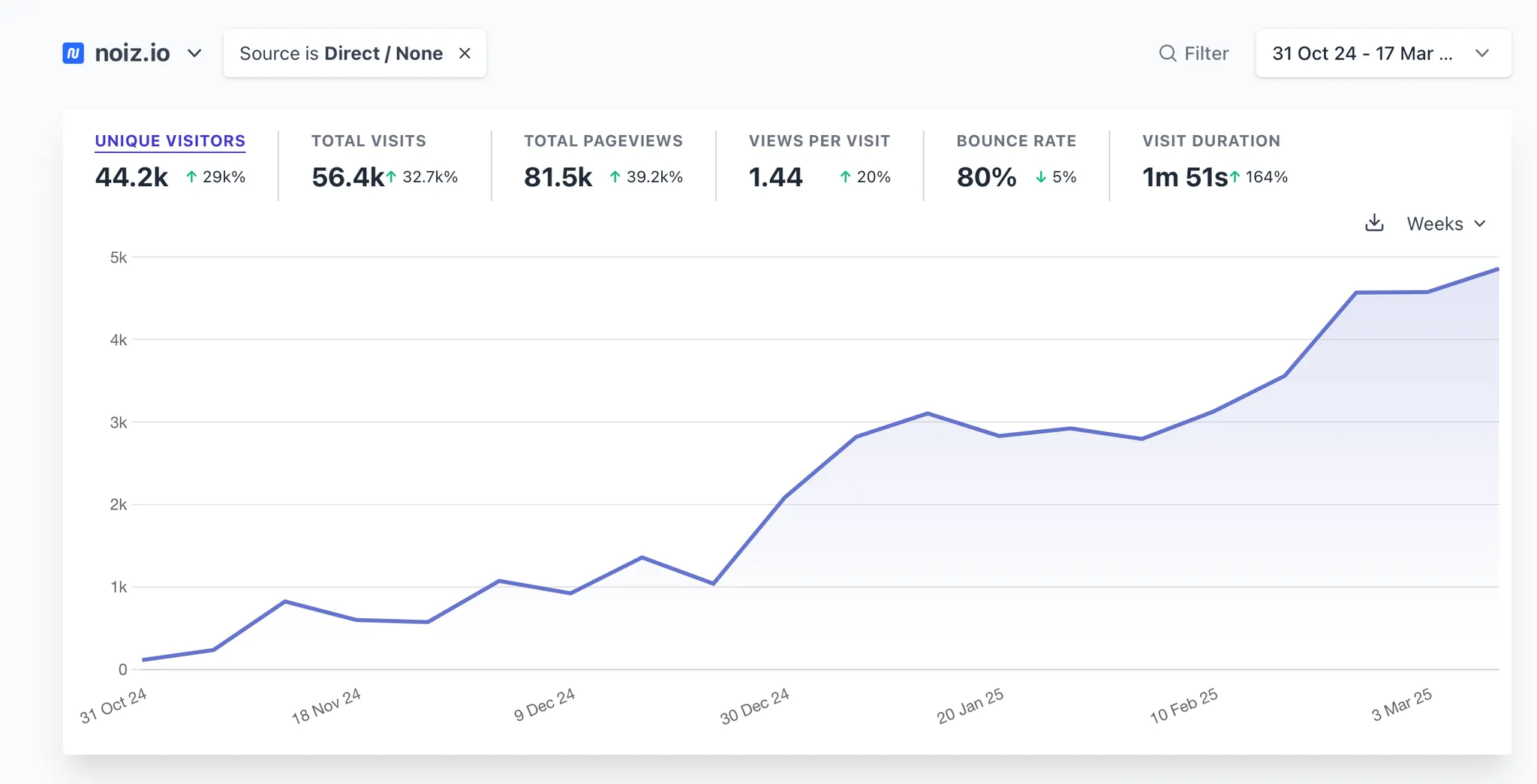
UGC content creation costs over 2 months: $2,600.
💰 Summary: Budget Breakdown
Our total expenditure for this growth initiative was strategically allocated to maximize ROI. By focusing on cost-effective methods and leveraging AI tools, we achieved substantial results with a lean budget.
Total project launch costs ~$37,903 in direct expenses:
- $8,000 – domain purchase
- $6,103 – content
- $7,200 – link building
- ~$14,000 – SEO manager
- $2,600 – influencer content Plus our time creating tools, page layouts, et
The result is a specialized AI resource with rapidly growing organic traffic, primarily from tier 1 countries. In 20 weeks, our client’s weekly traffic grew almost 55.9x and continues rising. Even if our growth rate significantly slows, our model projects over 200,000 installations next year. The cost per installation will be several times cheaper than any performance channels, making our partnership with our client and their platform an extremely promising investment.
📞 Ready to Use This in Your Business?
Let’s walk through your site, your product, and your growth goals —
and see how we could clone this exact system for you.
Book Your FREE Call NOW. Seats are limited.
Value-stacked 1-on-1 consultation. You’ll walk away with real strategies—including 2/3 actionable steps you can implement immediately.

